












This report has been prepared by:
ROSS Planning Pty Ltd
ABN 32 508 029 959
Upper floor, 63 Bay Terrace
Wynnum QLD 4178
PO Box 5660
MANLY QLD 4179
P: (07) 3901 0730
E: info@rossplanning.com.au
W: www.rossplanning.com.au
Sport and active recreation activities play a major role in contributing to the Northern Tasmanian community’s strong sense of wellbeing. The sporting networks are not limited by Local Government Area (LGA) and operate across all five LGA’s within the Study Area, as well as servicing the broader region. With the community also hosting major sporting events at many of the existing facilities, it is important that each of the five Local Governments can plan for the future through a consolidated plan.
Sporting facilities play an important role in supporting happy, healthy, thriving, connected and engaged communities.
While sport and active recreation can include a range of informal and formal activities, this Plan addresses planning and provision of formal sport and active recreation facilities.
Future directions have been informed by:
assessment of current facility supply
assessment of existing facility usage
consideration of facility catchments and forecast population changes
review of engagement outcomes
analysis of trends
analysis of demand, opportunities and constraints.
The Sports Facility Plan presents future directions underpinned by the following guiding principles:
collaboration
sustainable
adaptable
efficient
diverse.
Overall, the sport and active recreation network is well provided for and in reasonable condition. There are key sports that are at capacity, only to be exasperated by future population growth as well as growth in the sport. The future directions identified aim to address this by identifying a number of additional facilities and undertaking facility upgrades.
In addition to the local survey data collected for the development of this Plan, national and state data can assist in building a picture of formal, club-based participation in sport and active recreation within Northern Tasmania.
Relevant to the Plan, the following table highlights sports that have a high participation rate at a national, state and local level. This information has been considered along with other key demand drivers and is discussed later in the report.
# Athletics is athletics/running and is skewed by the inclusion of ParkRun for adults
*Northern Tasmania Sports Facility Plan 2022 Community Survey 1 Ausplay 2022
Consistent with the National and State trends in participation, the Study Area shares a number of the high participation sports including AFL, Basketball, Cricket (children), Football (Soccer), Gymnastics (children), Netball (children), Swimming and Tennis. The differences for the Study Area are the high local participation in Hockey and the lower participation in Cycling.
Based on detailed assessments undertaken throughout the development of the Plan, the following sports have been identified as high priority. Additional findings for the complete list of sports are outlined within section 6 of this Plan.
Sport Justification
Basketball
• high national and state participation
• higher local participation than national and state
• trending growth in the sport
• there is a lack of compliant, indoor multi-court facilities within the study area, with demand far outweighing existing provision
• current under-supply of approximately 12 indoor courts
Strategic projects
• the concept plan for the Northern Suburbs Community Hub in Mowbray indicates the provision of indoor courts for use by basketball
• proposed UTAS Stadium will predominately cater for high performance use
• NTCA master plan may consider the need for additional indoor courts
• future duplication of the Longford Community Sports Centre is recommended
• proposed UTAS Stadium will predominately cater for high performance use - ensure the needs of netball are included in the planning of this facility
• there is a need to identify a suitable location for the development of a future multi-court indoor facility to meet the growing needs of basketball
Netball
• highest female participation sport
• high national and state participation by children
• high local participation
• current under-supply of approximately 8 outdoor courts
• anticipated need for additional 14 outdoor courts by 2036
• there is a lack of compliant, indoor multi-court facilities within the study area, with demand far outweighing existing provision
• sport is at capacity and growth is restricted
• the concept plan for the Northern Suburbs Community Hub in Mowbray is planning four dedicated indoor netball courts by mid 2025
• there is a need to identify a suitable location for the development of a future multi-court indoor facility to meet the growing needs of netball
• future duplication of the Longford Community Sports Centre is recommended
• undertake court re-surfacing and expansion to meet runoff requirements at Northern Tasmania Netball Centre
• the future focus for netball is on the provision of indoor courts whilst maintaining the current outdoor provision
Football (Soccer)
• high national and state participation
• strong local participation
• trending growth in the sport
• current under-supply of approximately 7 fields
• anticipated need for 13 additional fields by 2036
• NTCA master plan may consider additional fields
• Football Federation Tasmania has identified a synthetic pitch as a key priority for Launceston
• new multi-field facility is required, to be potentially located at in the growth areas of Legana, St Leonards or Perth
AFL
• high national and state participation by children
• strong local participation
• trending growth in the sport
• a number of facilities are over-capacity with too many ‘home’ clubs
• current under-supply of approximately 4 ovals
• anticipated need for 9 additional ovals by 2036
• NTCA master plan may consider additional ovals
• two new multi-oval facilities are needed in key locations close to population centres
• Deloraine Recreation Ground re-development may provide opportunity for multi-oval facility
This Sports Facility Plan is the first phase in a long-term planning initiative of five councils within the Northern Tasmania Region: the City of Launceston, West Tamar Council, Meander Valley Council, Northern Midlands and George Town Council.
The Plan focuses on sport and active recreation facilities to ensure that the long-term needs of the community are adequately catered for. The Plan is intended to complement national, state and regional plans and strategies, and will feed into local planning processes of the five councils.
It has been developed through sport facility inspections, engagement with both internal and external stakeholders and detailed analysis.
Member Councils of the Northern Tasmania Development Corporation collectively provide sport infrastructure in a sustainable and equitable way, to support participation in a diverse range of active recreation pursuits, that contribute positively to the mental, emotional, and physical health and wellbeing of residents and visitors.
The guiding principles describe the over-arching intentions for the provision and management of sport and active recreation facilities for the Northern Tasmania Region.
Councils within the Northern Tasmania Development Corporation are committed to working together to achieve shared outcomes for the Region.
Sustainable Investment in sport infrastructure results in an improvement and positive impact on the economy, the community, and the environment.
Planning, design, and construction of sport facilities accommodates the potential for changes in demographic and participation trends and provides opportunities for innovation in response to changes.
Investment of resources into sport infrastructure achieves the most benefit possible for the community.
The diversity of our communities is valued, and unfair and inappropriate barriers to participation in active recreation are identified and removed.

























The Northern Tasmania Region is located in northern Tasmania and is bounded by the Tasman Sea in the north and east, the Glamorgan Spring Bay Council area, the Southern Midlands Council area and the Central Highlands Council area in the south, and the West Coast Council area, the Kentish Council area and the Latrobe Council area in the west.
The Sports Facility Plan, encompasses five local government areas: the City of Launceston, Meander Valley Council, Northern Midlands Council,George Town Council and West Tamar Council. These five local government areas encompasses 11,224 square kilometres.
The Region includes rural, rural-residential, urban and holiday areas. Major features include national parks, islands, conservation and nature reserves, heritage buildings and historic sites, lakes, hiking and mountain biking trails, ski fields, and diverse agricultural, processing and manufacturing facilities.
Half of the Region’s estimated population of 136,687 reside in the City of Launceston, the major urban centre, with the remainder living in numerous townships, small villages and settlements. Industrial and maritime land use is located largely in George Town, around the Bell Bay Port. Rural land is used largely for agriculture, particularly dairy farming, sheep grazing and crop growing. Forestry, tourism, mining, viticulture and fishing are also important industries.
The Northern Tasmania region included in this study has experienced steady population growth over the last decade to reach an estimated 136,687 residents in 2021. Much of this growth has occurred since 2016. Significant aging has been observed across this time, with the region having a median age over 42 years in 2021. Interestingly, the younger age cohort residing in Launceston (where the median age is 39 years) counterbalances the older populations across the other four LGA’s. (George Town Council is particularly old – with a median age of 49 years).
Based on anticipated growth rates, the region population is expected to increase to more than 160,000 by 2036. It is projected that the trend for aging will continue, with the proportion of residents aged 65 and older expected to increase. There is potential for the Meander Valley, Northern Midlands and George Town councils to see decreases in the actual number of young people 0-24 years looking forward.
These changing demographics may mean there are likely to be fewer residents from the key age groups representing formal sport participants. Council, peak sporting bodies and local clubs should continue to plan carefully for sports facilities (with a focus on renewal and upgrading of existing facilities rather than necessarily looking to construct additional facilities and venues).

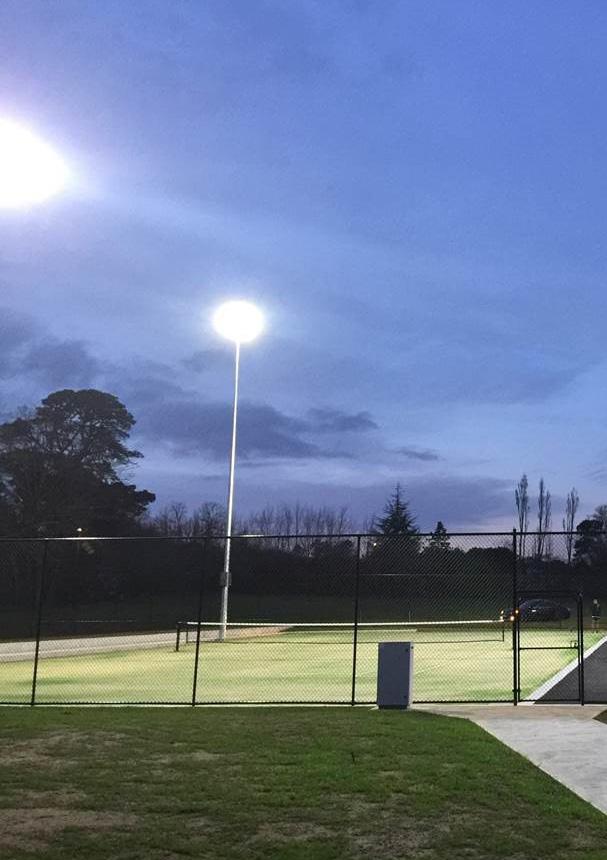 Campbell Town Tennis Courts
Campbell Town Tennis Courts
The intent of the Northern Tasmania Sports Facility Plan is to provide an evidence-based approach to the strategic planning, development and management of sport and active recreation across the five local government areas of City of Launceston, George Town, Meander Valley, Northern Midlands and West Tamar.
The Plan is to be used as a mechanism to prioritise future investment and development of sports facilities across the five local government areas. The Plan should be applied as part of each council’s Integrated Planning Framework that includes the Community Strategic Plan, Delivery Program, Operational Plan and Long-Term Financial Plan.
The focus of the project is on indoor and outdoor sports facilities and grounds. The sports covered in the Plan are: basketball netball volleyball football (soccer)
gymnastics cycling futsal cricket
badminton equestrian roller derby tennis
martial arts AFL rugby touch football
athletics hockey BMX lawns bowls
croquet rowing
table tennis sailing
softball baseball swimming
The Sports Facility Plan considers those sports operating from Council-owned or -managed facilities - as these are the sports over which Council can have the most impact moving forward. It is acknowledged that there are a number of sports not covered by the Facility Plan given the nature of the associated land tenure (private ownership). While schools and private facilities have been acknowledged where they provide a sport or recreation opportunity to the community, they are not part of the Plan’s core analysis. Partnerships with schools and private facilities certainly form part of the Plan’s recommendations. For ease of reference, the document has been presented in a sport-by-sport nature.
Population projections for the study area are currently being developed by REMPLAN and will be available later in 2023. For the purpose of developing this Plan, population projections have been developed using growth rates for each individual local government area.
Further, the Plan recognises that the development, management and delivery of high-level infrastructure will be a collaborative approach between the State Government, councils and strong forward-thinking local committees. While this document sets the framework for future infrastructure development it is imperative that local clubs and management committees are provided the tools required to ensure suitable facility management and planning. Ultimately, the successful promotion, use and upgrade of facilities will largely fall on these groups.
The project program spans across seven stages as depicted in the figure below.
Sports Facility Plan process
Inception meeting Engagement framework
SPORTS FACILITY AUDITS
Individual site assessments External site considerations
NEEDS ASSESSMENT
1 3 5 7 REVIEW AND FINALISATION
Current and future gap analysis Situational analysis and opportunities
Final draft review Finalisation
BACKGROUND RESEARCH ENGAGEMENT
Document review Demographic considerations Trends considerations
Council Sporting clubs and associations Community Identified stakeholders
DRAFT DEVELOPMENT
Draft preparation Draft presentation
Understanding the makeup, needs and physical activity characteristics of the local community, projected population change, trends in sport and recreation planning and the local legislative context are all important factors that influence sports facility usage, planning and design.
Policies, plans and strategies reflect community aspirations and expectations representing an important context to sport and recreation planning. Therefore, the development of the Sports Facility Plan needs to fit within their framework.
A review of a number of relevant documents has been undertaken to ensure an understanding of the overall context for the Plan.
Documents considered include:
Greater Launceston Plan
Council’s Community Strategic Plans
Strategic Asset Management Plans
Sport and Recreation Strategies.
The Greater Launceston Plan is a major strategic project to develop a unified and holistic approach to coordinate the long term planning and management of the City and broader greater urban area (LGA’s of West Tamar, George Town, Northern Midlands and Meander Valley).
The Launceston City Deal represents a partnership between the Australian and Tasmanian governments and the City of Launceston. Its intent is to make Launceston Australia’s most liveable and innovative regional city. The original Deal was signed in April 2017.
Relevant to the Sports Facility Plan, the fourth Annual Progress Report for the Launceston City Deal, is the progression of the Northern Suburbs Community Recreation Hub. The hub is proposed to be a multi-purpose community facility providing up to three indoor sporting and recreation courts.
Council’s vision ‘‘Launceston, proud of its heritage, a vibrant and inclusive community that is creative and sustainable, inspired by its diverse opportunities and rich natural environment.
A City where people choose to live. Driven by the Greater Launceston Plan Direction: To enhance the liveability and amenity of Northern Tasmania.
Community Strategic Plan
Operational Plan
Delivery Plan
Key directions for the City of Launceston include:
to continue to offer an attractive network of parks, open spaces and facilities throughout Launceston
A diverse and welcoming city. Key directions for the City of Launceston include:
to plan services and facilities that recognise the changing demographics of our community.
Council’s vision is ‘Our communities are progressive, prosperous, proud!’
Relevant future directions:
prosperity for all in all aspects of life - healthy, active communities strategic priority: Knowing how to stay healthy and active and valuing good health outcomes. Eating well, active living, preventative health approaches getting and staying active. Participation in recreation, arts and cultural activities
progressive well-resources communities - sporting opportunities for all growing participation in sporting activities growing membership and leadership capabilities in sporting activities engaging young people in the sporting activities of their choice.
“The backdrop of the Great Western Tiers, the mix of urban lifestyle and rural countryside give Meander Valley its unique look and feel, offering livability and healthy lifestyle choices. A community working together growing for generations to come”.
Future direction 4 - A healthy and safe community. Strategic outcomes:
infrastructure, facilities and programs encourage increased participation in all forms of active and passive recreation.
Northern Midlands is an enviable place to live, work and play. Connected communities enjoy safe, secure lives in beautiful historical towns and villages. Our clean, green agricultural products are globally valued. Local business and industry is strongly innovative and sustainable.
Relevant mission: People and Place
Core strategies - Caring, healthy, safe communities - awareness education and service
all abilities sport and exercise facilities are available.
GOAL 4: West Tamar Council’s Community Department will actively support and encourage the inclusion and participation of community from a diverse range of backgrounds.
4.2 Recreation:
4.2.1 Review and implement the West Tamar Recreation Plan
4.2.2 Continue to support the development of the Windsor Community Precinct
4.2.8 Continue to support the development of the Exeter Recreation Centre
4.2.10 Promote activities and resources that encourage participation in and use of recreational activities and facilities.
Within the Study Area, each of the five Local Government’s have undertaken planning at a local level. A summary of the relevant plans and strategies are outlined below.
A number of strategic projects in the sport and active recreation realm are underway within the City of Launceston.
Council are currently undertaking a precinct master plan for the Northern Tasmania Cricket Association sports complex in order to improve the liveability of the community and wider region and improve facilities for all types of community sport.
The Tasmanian Government are undertaking an upgrade of UTAS Stadium to increase its capacity as well as building an adjoining 5000 seat indoor arena.
In 2021 George Town Council commissioned a Sport and Recreation Strategy for the local government area aimed at informing capital works priorities.
The top recreation and sport facilities used by surveyrespondents in George Town included:
walking tracks (26% of all respondents)
beaches (25%)
the George Town swimming pool (21%), and
the George Town Sporting Complex (19%). Many residents described a need to travel to fulfil their sport and recreation needs, usually to Launceston, which offers a much larger range of facilities that can cater to sport and recreation activities.
Community consultation found that many participants believed the playing surfaces at the George Town Sporting Complex (Blue Gum Park) were not up to standard, citing poor and uneven surfaces and ineffective drainage. Further, the tennis courts, cycling track and netball facilities were all cited as needing improvement, in addition to a lack of appropriate change rooms. A large contingent of respondents further cited issues with the facilities at the current swimming pool.
Relevant recommendations of the Strategy to this Plan include:
support private providers or peak bodies/clubs to deliver opportunities for kayak and sailing
in Hillwood, upgrade the local hardcourt with a multicourt for basketball, tennis and other recreational options
in Low Head, provide netting around the rear of the cricket pitch to allow casual cricket training and to add a basketball ring to the tennis court, to provide additional activities
upgrade existing outdoor sports courts across the municipality for “free-access” tennis and basketball and promote these.
In conjunction with the Sport and Recreation Strategy, a master plan for the George Town Sports Complex was also undertaken in 2021.
Relevant recommendations of the Strategy to this Plan include:
re-open the tennis courts for public use
redevelop the tennis and netball courts to provide a good court base, surface and lights, adjacent to a shared support facility, as demand requires.
remove the old cycling building and replace with a track side shelter commissaire’s box, appropriate fencing and arrange for velodrome users to share toilet facilities in old soccer building.
Council commissioned a business case for the upgrade of the George Town Aquatic Centre. Relevant to the Sports Facility Plan, the proposed aquatic centre will have fitness and community spaces and will provide the community with yearround swimming, therapy, fitness and allied health services.
The facility will be developed to add to the existing outdoor pool – as an integrated aquatic health and wellbeing centre. The re-development is proposed to have an indoor year-round 25m pool to complement the existing outdoor 25m pool.
Meander Valley
Council have recently undertaken planning for a number of key sporting facilities and are seeing the facilities being constructed.
The Deloraine Squash Courts and Pump Track are currently under construction and will provide important community infrastructure.
The Deloraine Netball Courts have been recently constructed with the club already utilising this facility.
Northern Midlands Council has in recent years developed master plans for its six recreational grounds to gain a clear understanding of what the current user groups require for their sporting activities, and to identify solutions for the future that can be integrated and consolidated within the grounds and existing infrastructure.
Council is progressively implementing the master plans, utilising Council funding and assisted by grants secured from State and Federal Government funding programs, AFL Tasmania, Cricket Tasmania, Stronger Communities Fund sand the Tasmanian Community Fund.
To date Council has:
developed a new multi-function centre/clubrooms and meeting rooms with inclusive changerooms at the Campbell Town War Memorial Oval Precinct, and two new tennis/multipurpose courts
renovated and expanded the Cressy Recreation Ground clubrooms including constructing new inclusive changerooms. The cricket practice facility is currently being upgraded
significantly upgraded the Cressy Swimming Pool Complex including renovation and modernisation of the kiosk and storage area, creation of a new entrance, construction of a raised shaded and sheltered deck, gel coating of the two pools and relining of the main pool
renovated and expanded the Morven Park clubrooms including constructing inclusive changerooms and installing a new three bay cricket practice facility
renovated and expanded the stadium and function rooms at the Longford Recreation Ground including the construction of new inclusive changerooms, and a grandstand makeover
collaborated with Veterans Cricket Tasmania to develop turf wickets at the Ross Recreation Ground
undertaken upgrades to the oval lighting at Campbell Town, Evandale, Longford and Perth
installed electronic scoreboards at Campbell Town, Evandale, Longford and Perth
redeveloped and expanded the Longford Community Sports Centre.
Perth’s current recreation ground has a number of ageing sporting facilities, including the skatepark and an inadequate size oval. The ground is adjacent to the Perth Primary School that requires additional land for expansion to cater for growing student numbers. Council has developed a concept plan for the development of a green field site into a regional facility including a combined AFL and cricket oval, a multipurpose community centre, new netball and tennis courts, an adventure playground and skatepark/pump track and possibly an aquatic centre and/or football field.
West Tamar Recreation Plan
Council commissioned the West Tamar Recreation Plan in 2013 with a focus on the need for a strategic, planned and coordinated approach to the provision of sport and recreation. The Plan recognised the popularity of unstructured recreation activities.
Strategies of the Action Plan relevant to this Plan include:
maintain a commitment to planning for facilities, open spaces and other recreational settings
continue to adopt a planned approach to facility development where major infrastructure proposals are only supported if there is a clearly identified community need and a gap in provision
ensure local development priorities are consistent with regional and state priorities and policies
maintain, upgrade and develop sport and recreation facilities and infrastructure with a focus on increasing participation, encouraging shared use (where feasible), and providing access for all ages and abilities to a variety of activities
ensure the provision of facilities, infrastructure and open spaces reflects participation trends in sport and recreation and responds to local demographic characteristics
form strategic partnerships with state government agencies, state and regional sporting organisations and the community
improve the management and programming of Council owned facilities to maximise the efficient use of existing infrastructure.
The Strategy identifies the Riverside Swim Centre is nearing the end of its useful life after conducting a detailed condition assessment. Relevant to this Plan is the re-development of the Riverside Swim Centre to cater for the aquatic needs of the West Tamar and surrounding communities into the future.
The Australian Government has a clear vision for sport in Australia:
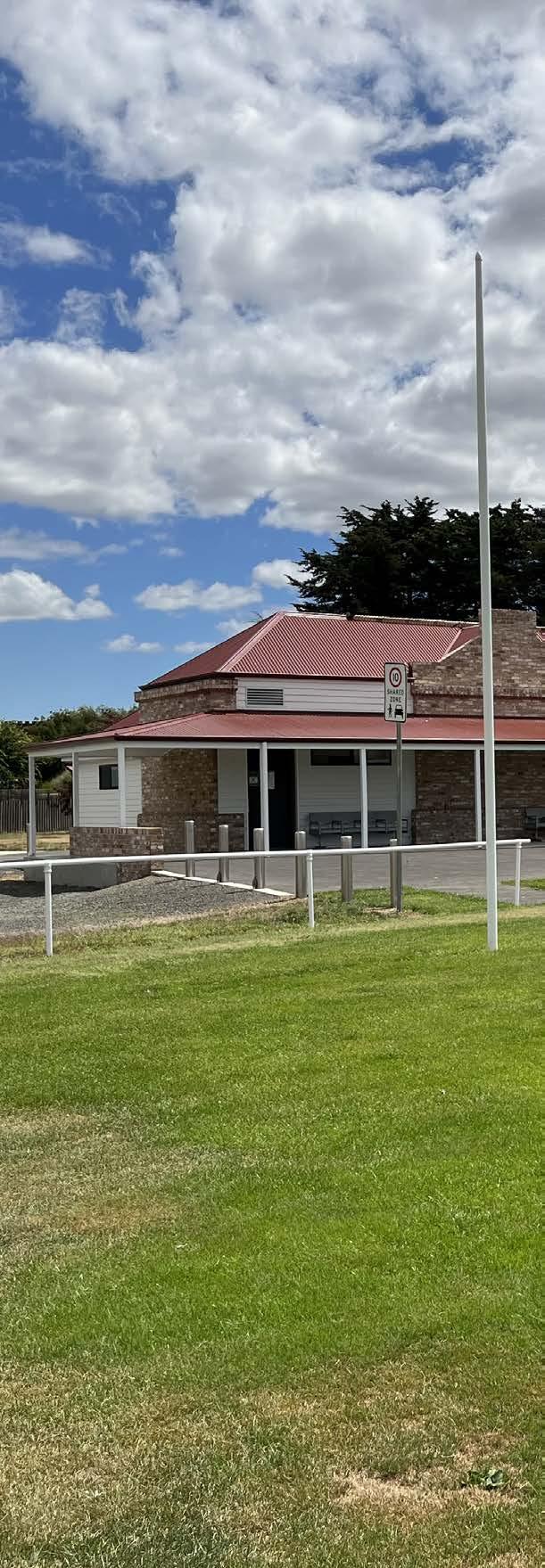
‘to ensure we are the world’s most active and healthy nation, known for our integrity and sporting success’.
The document highlights that fewer Australians are playing sport and engaging in physical activity, a trend needing to be reversed.
Informed by a comprehensive consultation process, Sport 2030 is Australia’s first national sport plan representing the Australian Government’s long-term commitment to seeing Australian sport thrive. Relevant to the Sports Facility Plan, the National Sports Plan has the following principle for action:
sport and physical activity for all, for life: every Australian, at all stages of their life, can undertake the exercise they need and want in a safe, fun and inclusive way, whether it is through sport or other types of activity.
Sport Australia will have a primary focus on sport and the sports sector. However it will be able to use the reach and influence of the sport and physical activity sectors, local, state and federal government agencies, as well as the community and private sectors as partners, to drive awareness, inspiration and behaviour change. Sport Australia is also currently responsible for delivering the Sporting Schools Program for the Australian Government.
The Tasmanian Community Sport and Active Recreation Infrastructure Strategy - Draft outlines the Tasmanian Government’s approach to ensuring infrastructure is developed to address community needs.
The Draft Strategy is based on previous and ongoing community consultations with stakeholders.
The purpose of the Strategy is to guide future investment decisions for community sport and active recreation infrastructure in Tasmania.
The strategy outlines key principles in which to inform future actions and investment decisions of the Tasmanian Government relative to community sport and active recreation infrastructure in Tasmania.
Relevant to the development of this Sports Facility Plan, the Strategy presents two objectives for community sport and active recreation infrastructure in Tasmania, being:
infrastructure development is prioritised according to evidenced community need and sound investment criteria; and infrastructure is developed in collaboration with communities, user groups and facility providers. The Strategy outlines infrastructure categorisation for community sport and active recreation, which have been adapted and used in the development of this Plan.
The Tasmanian Government is developing a strategy for sport and active recreation to ensure its initiatives and investments are guided by a long-term vision. The Tasmanian Sport and Active Recreation Strategy will provide a strategic framework for sport and active recreation in Tasmania over the next eight years (2022-2030).
The discussion paper has been written as an engagement tool to assist in the development of the ultimate Strategy. It outlines the vision for ‘Tasmania to be the Place to Play’.
The subsequent objective is to ‘increase participation in sport and active recreation’.
This objective is supported by a number of focus areas, of which the relevant areas are provided below;
1. enable increased participation for all
2. build stronger organisations
3. support pathways to high performance
4. provide access to infrastructure, facilities and spaces.
The Strategy once developed, will provide strategic directions to guide the focus of Tasmanian Government support and investments in sport and active recreation.
Since 2015, Sport Australia has conducted a national sport and physical activity participation survey, Ausplay. The most recent results of the survey were released in October 2022. In 2011-12 and 2013-14, a similar survey, the Participation in Sport and Physical Recreation Survey was conducted by the Australian Bureau of Statistics (ABS). Between 20012010, the Exercise, Recreation and Sport Survey (ERASS) was conducted by the Committee of Australia Sport and Recreation Officials (CASRO).
Overall, participation in physical activity has increased in the last two decades. More adults participate more frequently compared to 2001. Female participation (at least once a year) has remained on par with male participation throughout. However, more women have constantly participated more often.
Participation in sport-related activities has decreased, while non-sport physical activities have increased significantly (by more than 20 percent since 2001). Participation in recreation activities such as walking and fitness/gym have increased the most.
More children participate in organised (out-of-school) sport, than adults. The top activities children participate in changes as children age, with a focus on the life skill of swimming for infants and toddlers and running, fitness/gym, football (soccer) and walking being the dominant activities by the time children reach the ages between 15 and 24 years old.
National participation rates in organised sport have been declining for a number of years as participants move toward more social (drop-in drop-out) sport and informal recreation. It will be important for Council to monitor participation trends into the future to ensure resources are allocated appropriately to support a broad range of both recreation and sport activities.
Cycling has been reported as one of the top five sport and physical activities from results of all of the AusPlay surveys since 2015. Over 90% of participation in cycling is nonorganised, with only 8% of cyclists participating in organised competitions.
Mountain bike riding has been steadily increasing in popularity over the last decade. Local Government’s in Tasmania have recognised this trend and has worked with the local mountain bike community to develop, maintain and promote a range of mountain bike trails across the state. These trails have quickly become very popular with both locals and mountain bike ‘tourists’.
The past decade has seen a steady increase in registered BMX club members at a national-level. Launceston is home to a high quality BMX facility - Launceston BMX Club that regularly hosts national-level events. BMX bikes are also popular for non-competition recreation and skate parks are popular locations for BMX bikes (as well as other wheeled recreation devices, such as scooters).
Pump tracks are also becoming one of the more popular recreation facilities for all ages, catering for mountain bike, BMX, pedal-less balance bikes, scooters and skateboard riders consisting of rollers and banked turns (berms).
The various forms of cycling and the growing popularity of all types of bike riding supports evidence of a shift away from structured sport to unstructured recreation. Cycling is also growing in popularity as an active transport method.
There are acknowledged benefits of developing dedicated multi-use sports precincts (rather than single-field facilities). Large flexible-use sites provide opportunities for shared use of infrastructure and maintenance requirements and enhanced ability to attract funding given the range of users. There are a number of existing multi-use facilities throughout the study area (including Churchill Park, George Town Sports Complex, Prospect Vale Community Park, St Leonards and Windsor Community Precinct amongst others). These larger facilities allow for shared use of facilities such as playing fields, amenities and car parks and result in reduced resource demands.
There is a clear move toward sports providing ‘year-round sport’ through lengthening seasons and providing ‘off-season’ alternatives. This season lengthening impacts opportunities for recreation time choices and will place additional capacity and timing pressures on sporting facilities.
With many sports extending the lengths of pre-season and season fixtures, sharing of field space is becoming more difficult. While providers strive to maximise the use of community resources (and State Government espouses field sharing), the reality is that shared use of ancillary facilities (e.g. clubhouses, car parks) rather than fields is more likely. Opportunities may exist in some cases for clubs to utilise suitable school facilities for pre-season training to reduce conflict where field sharing exists.
Facility providers face an increasing trend to develop sporting fields and courts to a higher standard in order to increase carrying capacity. Upgrades, such as lighting, field irrigation and turf varieties allow training and competition times to be extended and increases the ability of turf playing fields to cope with the resulting wear and tear. Further, to achieve ongoing field quality, fields need ‘rest periods’ (of up to four weeks) where necessary maintenance can be undertaken.
The replacement of turf fields with synthetic fields, however, can significantly increase carrying capacity by limiting maintenance-required field down time. A number of facility providers are moving toward the provision of synthetic fields (particularly for football (soccer) and hockey where internationally certified surfaces are available).
Anecdotally, there is an emerging trend toward sport participation indoors (e.g. basketball, netball and fitness). Potentially, this move may be a result of a preference for activities in a controlled climate and/or greater midweek opportunities (compared with outdoor activities and traditional Saturday or Sunday fixtures). Basketball and netball have enjoyed significant growth in recent years while many of the outdoor formal sports have noted steady or decreasing membership.
Relevant points in relation to indoor sport include:
indoor sport is more convenient and reliable
often, an indoor facility is the sports association ground. There are no home or away locations, making it easier for families as only the time of games may vary
the game or activity is not influenced by weather
the sporting season is consistent as there are no wet weather make-ups
design standards allow for greater accessibility and comfort
there are often seating areas, changing rooms, toilets and a canteen area
easily accessible for parents with prams and for those with mobility issues.
More people are choosing to play sport for social reasons. Many indoor sporting facilities offer social leagues in netball, basketball, volleyball, cricket and roller derby. The combination of the convenience and reliability of indoor sport and the canteen/bar area of indoor sports centres, sporting codes are observing a significant increase in their indoor and social competitions.
Road cycling, mountain biking and eco-tourism activities are all growing as non-traditional physical activities, while modified sports such as T20 cricket are burgeoning. Changes are placing additional pressure on councils with regard to playing field capacity, facility flexibility and the need to plan for additional demand.
Shift work, increases in part-time and casual employment and family commitments influence participation as:
people do not have the time to commit as a regular participant or volunteer
people seek facilities and participation opportunities with flexible hours.
If membership stagnation or decline continues to be a concern for the study area user groups, additional delivery models such as social fixtures or ‘pay as you play’ approaches should be considered.
Female participation in ‘traditionally male’ sports
There is a current focus on the role of sport in promoting gender equality from all levels of government. This has seen significant resources put into marketing and promotion targeting female participants.
Those traditional sports reporting participation increases at State- and National-level largely have significant increases in female participation to thank (with many noting steady or decreasing participation by males).
Sports such as cricket, football (soccer), rugby league, AFL and rugby union have all seen increases in female participation due to targeted marketing and an enhanced presence in social and mainstream media (e.g. televised matches and greater print coverage).
These increases have the potential to result in demand for additional gender-neutral (female-friendly) change rooms and further playing and training spaces.
There are indications that people may continue to engage in sport later into their old age1. The Australian Sports Commission highlights that organisations may need to provide a wider range of products tailored to meet the needs of older Australians.
The provision of opportunities for older participants will be particularly important in the study area, where the population is projected to age markedly. Fortunately, from a formal sports perspective, older participants generally require the same playing and ancillary facilities as younger participants.
Joint initiatives on education land Opportunities for sport and recreation groups to access school facilities can help reduce the demand or need to duplicate certain sporting infrastructure and/or to cope with the requirements of an under-supplied sporting network. It may be opportune for each council to help assist community sport and recreation clubs to negotiate ‘community use of school facilities’ agreements, thus, decreasing or delaying the need to provide particular facilities.
However, it is important to note that community use of existing school sports facilities should generally be viewed as a short-term fix, rather than a longer term ‘solution’. Changes in school (and department) policy and turnover in principals can greatly impact on the accessibility of school facilities for the community. Limitations with existing facilities exist where there are no toilet and change room facilities that clubs and the community can use external to the schools facilities afterhours.
Negotiation with the Department for Education around the joint funding and use of sports facilities where a new school is being planned has seen greater, long-term success. An example of this occurring locally is the Launceston Christian School which adjoins Windsor Park.
The ability for Australians to be active in their communities has been interrupted since COVID-19 was first confirmed in Australia in late January 2020. In particular, the pandemic has had a significant impact on organised sport as these gatherings were put on hold to adhere to health advice.
As we continue to adapt to “COVID-normal”, AusPlay data is starting to show more evidence of how the participation habits of Australians are changing.
Compared to 2019, the average number of activities per person has increased. And fewer Australians are relying solely on sporting clubs or organised venues for exercise – they are more likely to be adding in “COVID-safe” unstructured activities.
Physically-distanced or home-based activities are continuing to increase in popularity including:
recreational walking
bushwalking
tennis
pilates
mountain biking
canoeing and kayaking.
Participation in other activities that increased significantly in 20202 (running/jogging/athletics, cycling, swimming, yoga, golf and fishing (recreational)) levelled off in 2021. Participation in many other sports and activities has taken longer to increase.
Covid-19 has further highlighted the social and mental health benefits of exercise for Australians aged 15+;
37% were motivated by the social benefits of participating (up from 30% in 2019)
30% were motivated by the mental health benefits they gained (up from 21% in 2019).
Most participants in sport and physical activity are still motivated by physical health/fitness or fun/enjoyment but the importance of social (such as meeting up with friends) and mental health benefits continue to grow. In 2021 women were more motivated by mental health benefits (36%) than men (24%). Motivations for sport and physical activity for both males and females combined:
physical health or fitness 83%
fun/enjoyment 48%
social reasons 37%
psychological/mental health/therapy 30%.
Covid-19 has changed where Australians get active. The most marked change was in the use of public space for sport and physical activity among Australians aged 15+. This trend is apparent across all adult age groups and across all top 20 sports and physical activities but has been most strongly driven by increased participation in recreational and bush walking, running, football (soccer), tennis and swimming.
Recent benchmarking clearly shows that a range of council maintenance and management models exist across Australia.
Within the study area the majority of user groups hire their facility from council, or have a lease with council. User groups contribute towards the cost of grounds and facilities provided by council so that ratepayers do not bear the full cost.
A range of fees and charges are used across Australia depending on council’s position on sporting facilities being provided as a community service obligation. However, it is interesting to note that all councils researched have fees associated with the use of sporting facilities.
A number of councils have based fees on recovering a set percentage of councils’ maintenance costs. These percentages range from 10% to 35%. The Australian Capital Territory has gone further by factoring in both maintenance and management costs into its recovery program.
It is most common for councils (or the government in the case of the Australian Capital Territory) to be responsible for field maintenance.
However, there are a small number of councils within Queensland where users are required to maintain sporting fields (particularly where leases apply).
In most instances, where buildings are leased, lessees are required to conduct all maintenance. Where leases are not in place, councils tend to conduct most maintenance with users responsible for interior maintenance and cleaning. It is difficult to summarise rates systems used. Rates vary from $0 (rates fully subsidised) through to users’ paying full rates. There are also vast differences in those rates and charges applicable to users (e.g. water rates, water consumption charges, sewerage charges, garbage collection charges, other statutory charges). In essence, council’s position on sport and recreation provision as a community service obligation determines the level of applicable rates and charges.
Councils currently use a seasonal licence model and sporting groups indicate that they are generally content with this process. However, in order for clubs to establish a ‘home’ and to be encouraged to conduct forward-planning and development initiatives, it is recommended that councils consider adopting a tenure policy for sport that includes offering users a permit to occupy (licence) over playing fields and the ancillary facilities (such as clubhouse, changerooms and storage) associated with these fields. Potentially, a range of lengths of permit may be possible (up to five years with five year option). Leasing sports fields to users is not recommended unless the club is seeking single use and committing significant resources into the facilities.
Sporting groups only require use of playing fields at those times booked for use. Outside these times, council should be free to conduct maintenance or make the fields available for additional users and the general public.
User groups should be encouraged and rewarded for sharing facilities.
In addition to understanding the views of formal sporting user groups and peak bodies, it was also important that the project reflected the needs of individual sports facility users. A community survey was circulated via the five LGA’s through their normal social media channels.
Reflecting the importance of formal sport across the study area, 1580 responses were received. While a number of responses were completed by residents living outside the study area, the vast majority came from the five LGA’s. Almost half of the respondents were Launceston City Council residents.
The table below highlights the average driving distance for respondents to attend the sports facility they use most frequently. Not surprisingly, respondents from George Town Council and Northern Midlands Council travelled significantly farther than respondents from other LGAs, while Launceston City Council respondents travelled less than half the distance of respondents from any other LGA.
Table 04: Average distance travelled by LGA
Respondents were asked to identify which sports they participated in within the Northern Tasmania region. Results have been described as a percentage of total respondents. The top 8 results were:
netball 25%
basketball 14%
AFL 9%
cricket 9%
soccer 9%
hockey 7%
swimming 6%
athletics 4%.
It is important to note that almost half of all respondents played a sport that is traditionally played indoors (or there is a preference for the sport to be provided indoors where practical). Given the often-uncomfortable weather conditions prevalent in the Northern Tasmania during the winter months, this preference for indoor participation is not surprising.
The venue most readily visited reflect the popularity of sports. By far the most common responses were for the Northern Tasmania Netball Association 15% and Elphin Sports Centre 9%. Other venues frequently visited include Northern Tasmania Hockey Complex, Silverdome, Northern Tasmania Cricket Association and Churchill Park. Interestingly, all of these venues are located within Launceston.
It is interesting to note that many respondents identified required traveling distances of more than 50km. Examples include:
95km to access mountain bike trails
92km for netball
81km for gymnastics
74km for cricket
67km for swimming
65km for football.
While these results indicate that respondents are prepared to travel significant distances to attend their preferred sports, it is important to note that one of the key barriers highlighted by respondents was the limited range of facilities provided.
Clearly, understanding existing barriers to participation can assist to guide decision-making, direct planning initiatives and ultimately direct resources. Respondents were asked to identify whether they had experienced any barriers to formal sports participation within the region.
Unfortunately, more than 87% of respondents identified at least one barrier to participation. The most commonly reported barriers (in order) include:
1. they are poorly maintained/unclean
2. they are too crowded
3. there is a lack of toilets
4. there is a limited range of sporting fields/courts/facilities provided
5. there is no shade
6. weather (too hot, too cold).
These findings generally reflect those outcomes from the formal user groups surveys, interviews with peak bodies and facility audit and assessments.
The following table provides the barriers reported by survey respondents for each of the LGA’s. The top three barriers for each LGA is highlighted in orange in the table.
Table 05: Barriers by Local Government Area
There are three key barriers that were common across the 5 LGA’s:
they are poorly maintained and/or unclean
there is no shade
there is a limited range of sporting fields/courts/facilities provided.
Respondents were asked to rate the quality of a range of sport playing and associated facilities on a 1-5 scale (with 1 being poor and 5 being great). If 3 is considered a ‘pass’, a number of facility types were identified as below expectations:
These results suggest that the outdoor playing facilities are at an ‘acceptable’ level (although only marginally) while the indoor playing facilities and the associated ancillary facilities are all in need of upgrade and further development.
Respondents were given the opportunity to identify the sport priorities they would fund if they were in charge of a Council within Northern Tasmania. This was an open question that received a wide range of responses. However, there appear to be six key priorities that have been identified.
additional indoor court sport facilities (particularly to cater for netball and basketball). This priority was identified almost ten times more than the second most common response
active recreation facilities (including skate facilities, mountain bike opportunities, BMX facilities and pump tracks)

quality equestrian facility within the region
additional soccer facilities
quality field lighting at existing outdoor facilities
upgraded hockey facilities. Here again, this prioritised actions reflect findings from other activities undertaken in the project.
In addition to understanding the views of the Northern Tasmania community, it was also important that the project reflected the needs of individual sports facility users. A sports club survey was circulated via the five LGAs through their social media channels as well as direct club contact where current club contact details were available.
Over 60 sports club surveys were returned across 16 sports. Responses were received by clubs from the following sports:
Tennis Cricket Roller Derby Badminton
Squash Table Tennis Lawn Bowls Croquet
AFL Netball Athletics Soccer
Baseball BMX Equestrian Taekwondo
Clubs were asked how far their members travelled to participate in their chosen sport at their regular facility. It is interesting to note the high proportion of members who travel between 20km and 50km. This figure is consistent with research that demonstrates people are willing to drive reasonable distances to the facility or sport of their choice.
Table 06: Club member travel time
Clubs were asked to rate the suitability of their facilities against a number of categories as shown in the table below.
The analysis of the sports club survey results and individual sporting club responses are included within the sport analysis section of this Plan.
In order to understand the demand for future facilities, a number of mechanisms have been used. It is important to note that no one mechanism will be solely used to determine future demand for facilities.
It is important to develop sports facilities that reflect the needs of the community. It is also important to have established desired standards of service (DSS) that direct facility planning, provision and embellishment. These standards are generally articulated as the preferred ‘minimum’ that Council strives to provide. DSS are generally categorised under broad measures:
quantity of land for sports facilities
access to sports facilities
level of embellishment.
The access and quantity standards are, traditionally, the two primary measures used to assess and plan for sport facility land demands. Unfortunately, it is not always possible to apply these standards, as provision of formal sport is opportunisticdependant on site-specific attributes (e.g. availability of suitable land) and local volunteers keen to lead formal sport.
In addition to the local club survey data collected for the development of this Plan, national and state data can assist in building a picture of participation in sport and active recreation within the northern Tasmania. This information is contained within the sports analysis section of the Plan, by individual sports.
Building upon the DSS land approach described above, a sports facility provision ratio technique has also become more commonplace as a planning tool in recent years. A number of peak sport bodies and councils (particularly those based in metropolitan Victoria) have prepared benchmark guides for facility requirements for individual sports i.e. 1 Australian Football field per 5,000 residents). The following considerations are worthy of noting for this approach:
opportunities to increase carrying capacity by provision of synthetic facilities (as opposed to natural turf)
opportunities to increase available hours of usage through field lighting
impacts of stand-alone year-round facilities compared with shared multi-use facilities
field shape and changing preferences - it can be difficult to convert ovals into rectangular playing fields.
Assessment of catchment areas and appropriate travel time/distances to sporting facilities to ensure that the majority of residents have access to a sports facility within a reasonable distance from their place of residence.
Engagement with local sporting clubs provides first hand information into their club membership and patterns of growth or decline, the condition and usage of their facility, as well as any required upgrades or improvements. This information is contained within the sports analysis section of the Plan, by individual sports.
From the models, it is also possible to determine land supply by looking at sharing of facilities across summer/winter sports. It should be noted that sharing between traditional winter and summer sports is not possible in all instances. Examples where this does not or cannot occur are:
where the field use (surface quality) is nearing capacity and it is not possible to offer sport on the same surface across the year, or where field maintenance mechanisms require prolonged periods of downtime
where artificial surfaces are used that are not suitable for the off-season sport use
in areas where participation data is higher for winter sports than summer sports, therefore greater land demand is likely
where the sport season (length) prohibits sharing
average field condition standards used, this can be greatly influenced by: field management regime employed and associated factors (such as quality of irrigation system, access to water etc.)
field use
climate
field capacity rates being based on what are considered industry standards, and, as such it is assumed that fields meet these standards before additional facilities are required. This is also greatly influenced by acceptable travel times.
The Tasmanian Community Sport and Active Recreation Infrastructure Strategy (Draft) proposes an infrastructure categorisation for sports facilities. This has been used in this Plan and adapted to include district level facilities, in order to better represent the existing facilities within the study area. The categorisation assists to plan and develop appropriate sports infrastructure and promote appropriate use of sports facilities. The sports facility hierarchy has been established for application to the network. The hierarchy identifies the size and scale of the facility and the embellishments required to provide sports opportunities.
Various sports facility types possess different values, functions and settings. Compatible and incompatible uses of sports facilities can result in impacts, changing their nature over time.
Assessment and allocation of sports facilities within a tiered hierarchy provides a useful framework for Council to manage the level and variety of embellishments in a particular facility level. The hierarchy also assists users expectations as they can select to attend facilities that provide the sporting experience and opportunities they are seeking.
This model covers traditional sports only and will not provide for a number of sport and recreation pursuits contained within this Plan such as BMX, croquet, sailing and martial arts.
Table
Table 09:
They are opportunistic in their provision and as such can not be given a typical size, accessibility or provision rate. Refer to the Tasmanian Community , Sport and Active Recreation Infrastructure Strategy (Draft) for their listed quality standards and supporting infrastructure.
dependent and very specialised in
Hierarchy Description
Major arenas and state level facilities
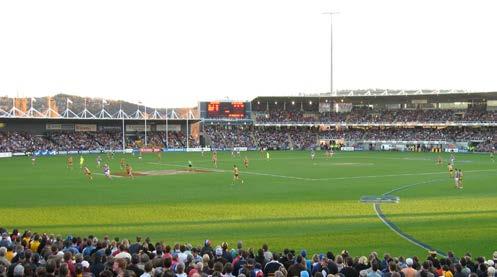
Large well-maintained sports facility likely to include multiple fields and courts. Is home to a range of user groups and has the capacity to host carnivals.
York Park Northern Athletics Centre
Example
York Park Northern Athletics Centre
Regional level facility
They have formally maintained sports field/ovals and/or courts for a mixture of winter and/or summer sports. The fields/ovals and courts comply and are maintained to State regulations for the sport codes using the grounds. Regional or higher level sports grounds generally include spectator seating, canteen buildings and multiple amenities buildings catering for the range of sports at the ground. Car parking will be extensive and the facility will be suitable to attract competition at a district, regional or (possibly) state level.
Windsor Community Precinct
Windsor Community Precinct Prospect Vale Community Park Northern Tasmania Cricket Association (NTCA) Ground

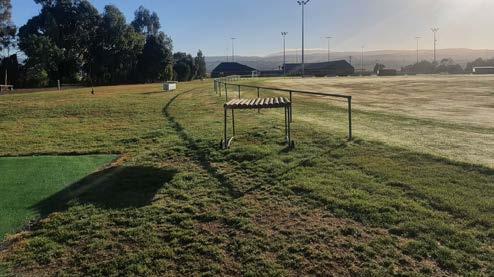
Prospect Vale Community Park

Hierarchy Description
District level facilities
District level sports facilities have formal to maintained sports ovals/fields for a mixture of winter and/or summer sports. The facilities would be of a good standard but may not have the required playing surface or ancillary infrastructure of a higher level facility nor comply with state regulations for the sport.
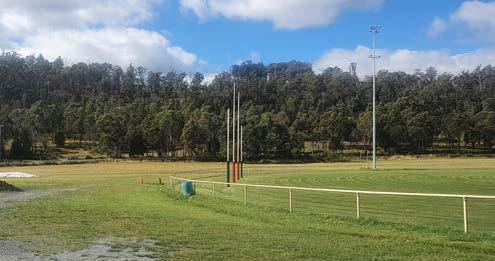
Bridgenorth Recreation Ground
Bracknell Recreation Ground
Example
Bridgenorth Recreation Ground Bracknell Recreation Ground
Local level facilities
Sports facilities that cater for local-level sporting competition. Typically a single field/oval or a small number of courts. Limited ancillary facilities are provided.
Deloraine Netball Legana Recreation Ground
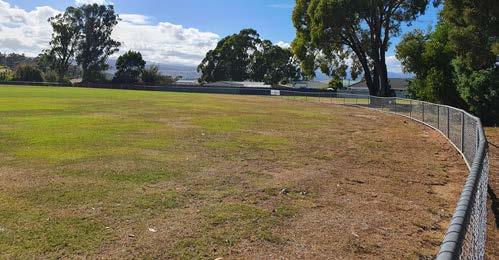
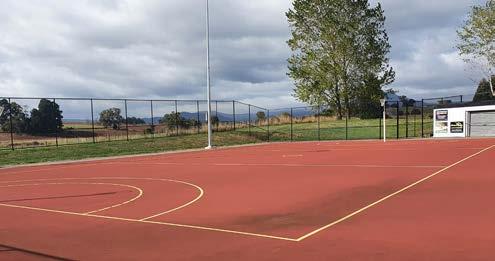
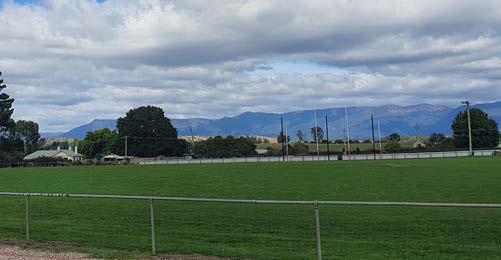

Deloraine Netball
Recreation Ground
Active recreation facility While these facilities are not considered sports facilities as such, they are generally facilities that support formal sporting activities.
George Town Pump Track
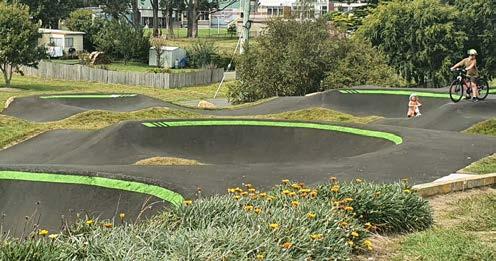
George Town Pump Track Riverbend Park Basketball
Riverbend Park Basketball
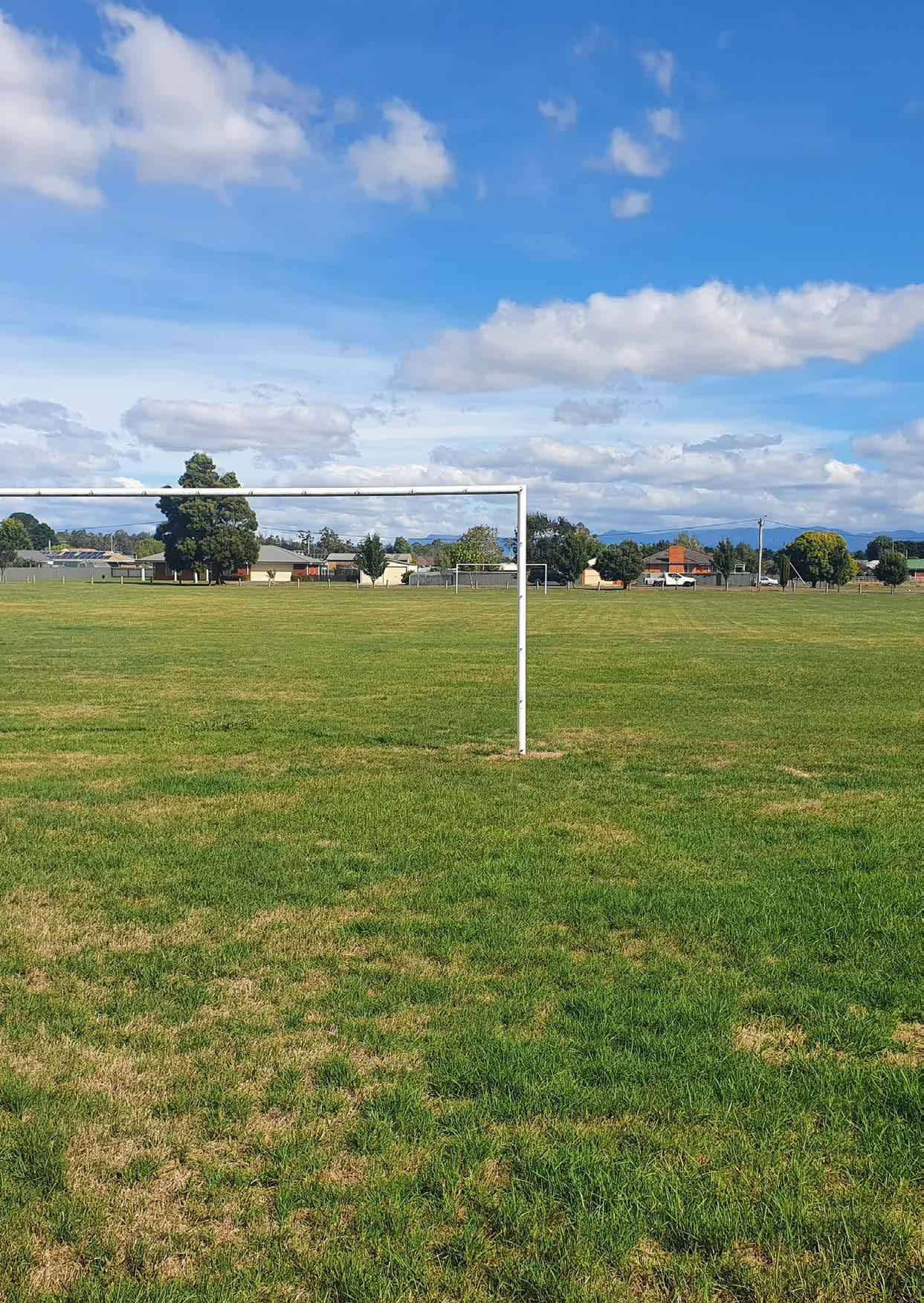 Carrick Memorial Park
Carrick Memorial Park
This model utilises generally accepted provision standards. These standards are based on likely demand for a playing area (field, oval or court) per population (e.g. 1 AFL field per 6,000 persons). These figures have been derived from a number of sources and the results are summarised in the table below. Provision standards aren’t applicable or available for all sports included within the scope of the project.
*Does not include the Silverdome due to inconsistent availability and focus on high performance sports and events
^No benchmarks for indoor netball court provisions currently exist
Table 11 purely shows the analysis of supply for each sport based on the standard per population. The need for additional facilities is considered in detail (with all contributing factors considered such as club membership numbers) in the individual sports analysis starting on page 44 of this Plan. The source of the above provision standards are outlined in the table below.
Sport Source
AFL AFL Tasmania Statewide Facility Strategy 2021-2030
Athletics City of Casey Leisure Facilities Development Plan Policy (Victoria)
Baseball City of Casey Leisure Facilities Development Plan Policy (Victoria)
Basketball City of Casey Leisure Facilities Development Plan Policy (Victoria)
Cricket As there are no exact provision rate provided by Cricket Australia or Cricket Tas, a generally accepted provision rate for cricket ovals is 1 per 4,000 people (based on similar studies undertaken for Queensland, Victoria and New South Wales local governments)
Soccer NSW Government of Planning Development Contributions Guideline 2009
Hockey Hockey SA Statewide Facilities Strategy
Lawn Bowls Bowls SA and Bowls Australia
Netball NSW Government of Planning Development Contributions Guideline 2009
Rugby Union City of Casey Leisure Facilities Development Plan Policy (Victoria)
Softball City of Casey Leisure Facilities Development Plan Policy (Victoria)
Tennis Tennis Victoria
The standard provision rates for each sport were sought in the first instance from each respective Tasmanian governing body. Applicable provision standards have been adapted from other sources where the Tasmanian governing body could not provide (the majority).
 Coronation Park, South Launceston
Coronation Park, South Launceston
To ensure that there is an equitable provision of sports facilities across the study area, a 5km accessibility buffer has been applied to the major sporting facilities of the core outdoor sports. This assessment excludes specialised or closed facilities such as lawn bowls, croquet, BMX, aquatic facilities, equestrian facilities and indoor courts due to their inaccessible nature to the general public i.e locked facilities and payment for entry.
An assessment of the mapping on the adjoining page shows that the population base of all five local government areas have direct access to an outdoor facility for sport and active recreation such as AFL, athletics, baseball, outdoor basketball, cricket, netball, soccer, hockey, rugby union and softball.
Beechford
George Town
Lefroy

Bellingham Weymouth
Pipers River
Beauty Point
Beaconsfield
Hillwood

Exeter
Legana


Bridgenorth

Riverside
Lebrina













Karoola
Lilydale

Rocherlea
Invermay



Trevallyn
Launceston
St Leonards
Prospect Vale
Hadspen

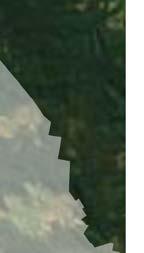


Deloraine Westbury Hagley Carrick
Perth Longford
Evandale



Targa
Bracknell






Cressy



 Campbell Town Ross
Accessibility of the Northern Tasmania population to the major sports facilities
Campbell Town Ross
Accessibility of the Northern Tasmania population to the major sports facilities
Facility use, club growth and carrying capacity of each site have been analysed to provide an initial assessment of existing facility carrying capacity to accommodate future growth in participation and use of existing and planned future facilities. The adjoining maps below provides a summary of each site’s determined carrying capacity. The sports analysis section provides further details for each site on any future sports to be accommodated and recommendations.
The site capacity is based on the following key:
Some capacity - the site offers opportunity for a nominated club or group to undertake their activity
At capacity - based on the current allocated sports and user groups, there is no opportunity for additional and/or alternate use
Over capacity - based on the current allocated sports and user groups, the site cannot cope with the demand on facilities. Some incompatible uses should be rationalised
Red and orange sites identified on the map are:















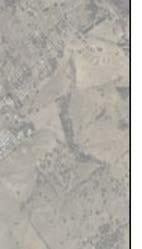
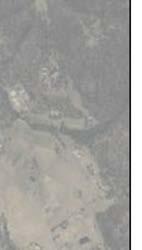
















Trevallyn Park
Churchill Park Sports Complex
York Park
Invermay Park



Elphin Sports Centre
NTCA Sports ground
Northern Tasmanian Netball Centre

St Leonards Sports Centre
Youngtown Memorial Park
Red and orange sites identified on the map are:



























Inset A - George Town Bowls Club

Red and orange sites identified on the map are:

































Inset B - Westbury Recreation Ground


Insert C - Prospect Vale Community Park

Red and orange sites identified on the map are:

































Insert A - Longford Recreation Ground and Perth Recreation Ground






Red and orange sites identified on the map are:














































Insert A - Windsor Park Soccer Grounds

Insert C - Edinburgh Park
An analysis of a number of sports and active recreation activities has been undertaken in order to inform future provision and facility development.
For each sport the following elements have been assessed:
existing facilities and the number of courts/fields/ovals
clubs and associations
registered player numbers (where available)
pattern of growth or decline in participation
carrying capacity of the site
distribution of facilities across the LGA
future direction of the sport
relevant actions from Council planning
relevant inclusion initiatives
key issues for clubs and the sport.
The information provided on the following pages has been taken directly from club and organisation surveys. Information listed under membership for each sport including projected participation, is based on the Club’s perception of their growth into the future. This information is supported by the consultant’s analysis of the sport’s local growth in relation to State and National Trends.
The following pages document this assessment and are provided alphabetically by sport:
AFL BMX Football Netball Squash
Athletics Cricket Gymnastics
Roller Skating Swimming
Badminton Croquet Hockey Rugby Union Table Tennis
Baseball Cycling Lawn Bowls Sailing
Touch Football
Basketball Equestrian Martial Arts Softball Tennis
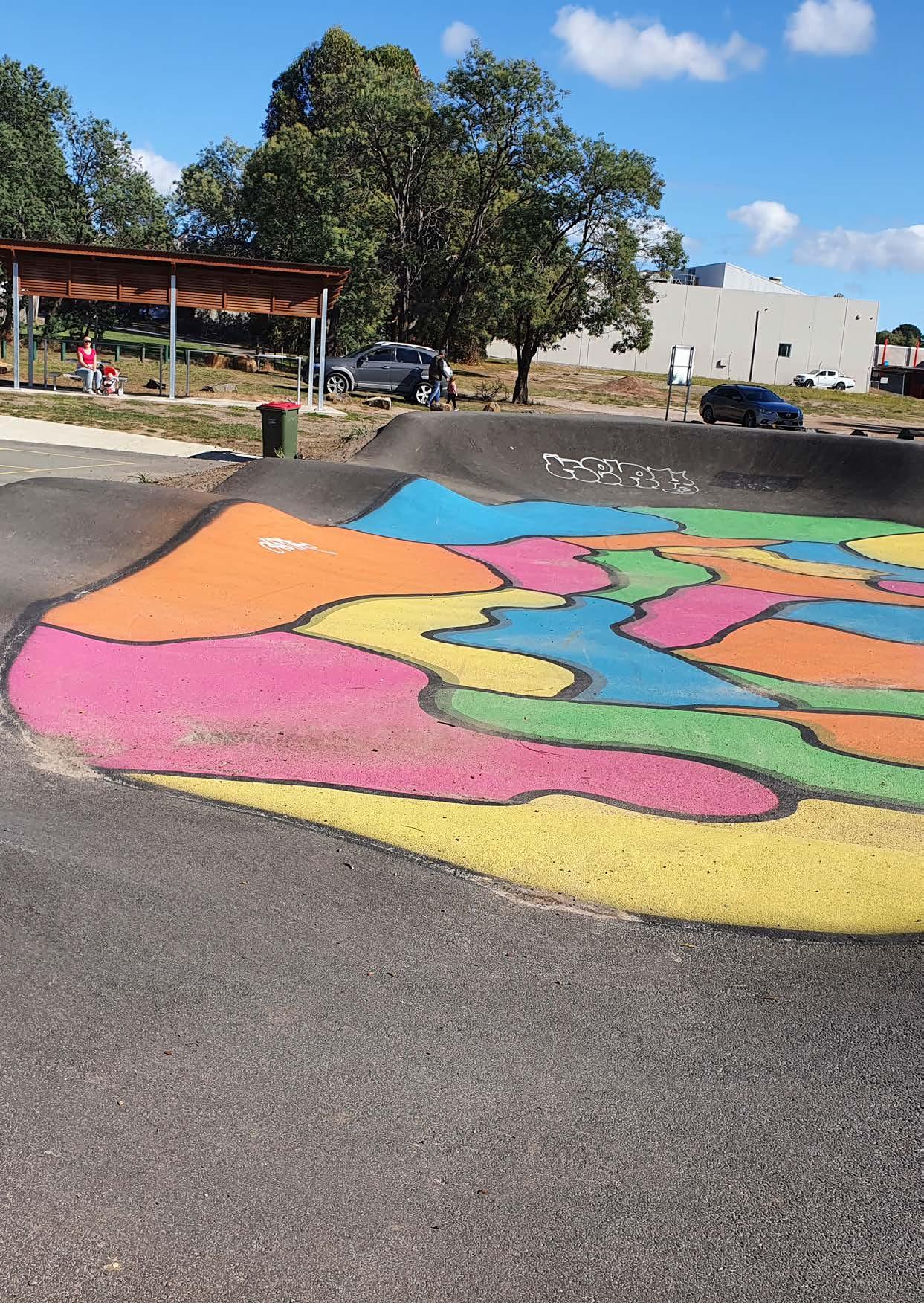 Legana Recreation Youth Space
Legana Recreation Youth Space
AFL is ranked 10th in the top sports and physical activities participated in by Australian adults in 20221 and 5th for children.
Australian football is ranked the 2nd highest sport participated in by Tasmanians for children and the 5th highest for adults in 20221. The current provision of fields and facilities in the study area reflects the ongoing popularity and growth of the sport. As the sport with the 3rd highest participation rate in the study area2 (equal with Cricket), participation in Australian football is projected to increase, particularly due to the rapid increases in female participation since the launch of the Women’s Australian Football League and the resources be allocated across the country to grow the game for junior female players.
Relevant to the growth of AFL in the state and locally, if Tasmania are successful in securing an AFL and AFLW team, the sport will continue to see high participation rates.
At a national level, participation in AFL is steady for children and increasing for adults. At a state level, AFL is fluctuating for children and increasing for adults (reflecting the national trend). Seven local clubs have provided their participation numbers across the five council areas. AFL Tasmania have confirmed these participation numbers and provided additional information where required. The table below presents the combined participation data from these seven clubs.
Australian football is the second most popular code of football in Australia and this is reflected in the current provision of fields and facilities in the study area.
AFL have access to at least 23 ovals across the Northern Tasmania study area. These facilities include:
a national-level stadium, UTAS stadium in Launceston
regional-level facilities such as Windsor Park Football Oval, Prospect Vale Park, Rocherlea Recreation Ground, Youngtown Memorial Park, Invermay Park and Morven Park Recreation Ground
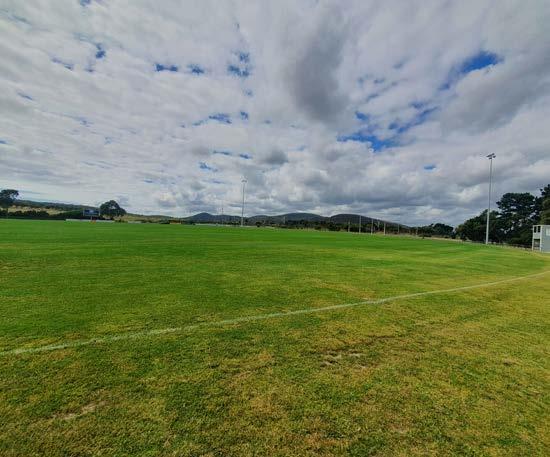

district-level facilities including George Town Football Oval, Bracknell Recreation Ground, Westbury Recreation Ground and Bridgenorth Recreation Ground
local-level facilities including Lilydale Recreation Ground, Deloraine Recreation Ground, Hillwood Oval, Beauty Point Recreation Ground and Ross Recreation Ground.
A full list of facilities and their hierarchy by Local Government Area can be found within Appendix 2.
There are very few multi-field facilities within the study area. Windsor Park offers 2 ovals (including the Launceston Christian School oval), and the York Park/UTAS Stadium precinct has 2 ovals.
In addition to the lack of multi-field facilities, there are very few opportunities for training near to the main field at each facility. Playing surfaces are generally in good condition at the commencement of the season across the study area. Due to the availability of only single-field facilities for both training and competition, by the end of the season the fields are in poor condition due to over-use and (in many instances) a lack of formal drainage.
A number of facilities currently have too many ‘home’ clubs creating scheduling and access concerns, and issues with field condition and capacity, including Invermay Park.
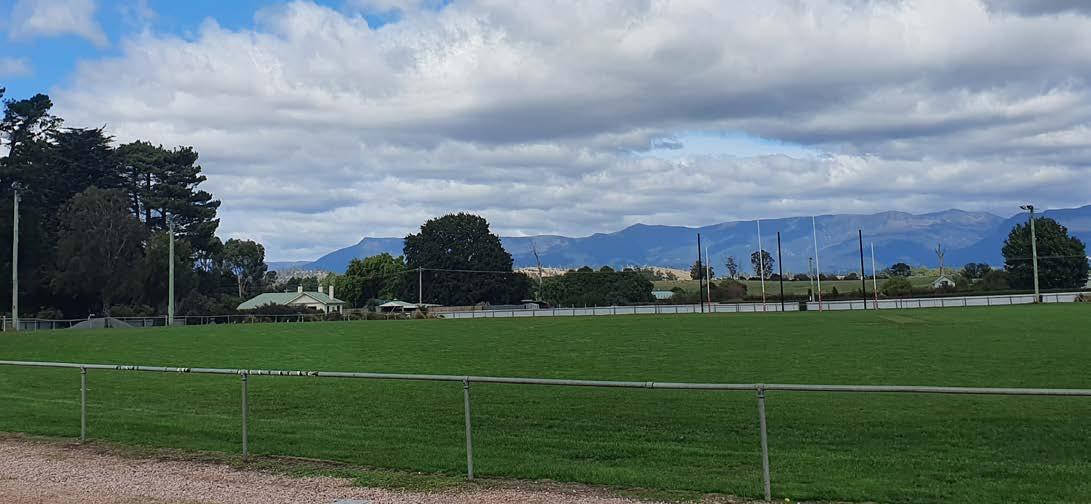
The study area does not currently meet the preferred provision ratio of 1 oval per 5,000 residents - with a current deficiency of 4 ovals across the study area. With the projected population, there is expected to be a deficiency of up to 9 ovals in 2036 (if no additional facilities are developed).
Lilydale Recreation Ground requires an upgrade to the entrance road and installation of spectator shade
Hillwood Football Club has identified the need for an upgrade to field lighting at Hillwood Oval
Tamar Valley Junior Football Club has identified the need for female-friendly change facilities at the Grubb Street Recreation Ground
East Launceston Junior Football Club at the NTCA has a desire for their own club rooms, enhanced field access for training (including pre-season) and improved field lighting. The NTCA cannot currently meet the training needs of all teams within the club
Meander Valley Suns Football Club at Westbury Recreation Ground has identified the need for a field lighting upgrade, as the current lighting limits use of the ground. They also have a desire for removal of the asphalt track that encases the oval to improve player safety; and the provision of spectator seating
Hagley Recreation Ground is used for training by the Meander Valley Suns and is in need of gender-neutral change facilities.
George Town Football Club has a desire to upgrade the toilets in their administration building
Longford Senior Football Club has identified the need to improve and formalise the second grassed area for training. Additionally, drainage and surface improvements are required to the main oval.
Due to increasing participation in AFL (particularly by children and women) it is expected that additional facilities will be required in Northern Tasmania’s population growth areas. The City of Launceston has experienced the highest growth in AFL participation within the State from 2016 to 2019 - increasing by 72%.
AFL Tasmania has prepared a number of strategic infrastructure objectives in regards to building facility capacity that are relevant to the Sports Facility Plan:
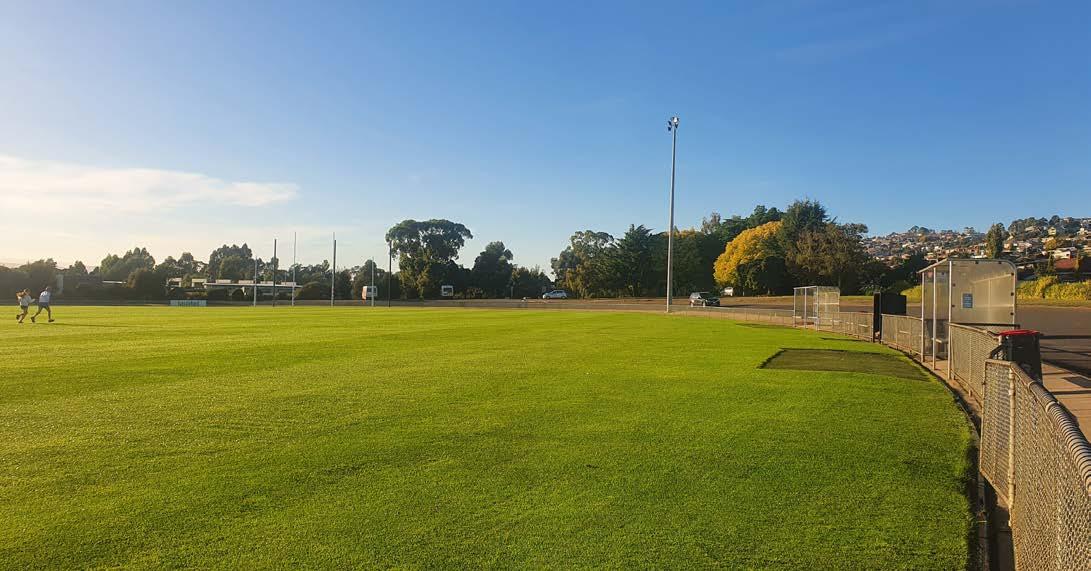
improve the carrying capacity of existing playing fields through improved ground design, drainage and irrigation
increase the quality and provision of sports lighting and deliver a minimum training standard LED lighting at all home grounds
explore synthetic / hybrid playing surfaces
shared use of facilities and co-location with compatible sports
secure greater access to non- traditional venues and schools.
Specific to the study area, AFL Tasmania recommends developing a new regional facility or expanding an existing venue, to accommodate a greater number of players due to the growth in the sport. Additional key issues identified by AFL Tasmania for clubs in the study area are:
increasing the number of facilities with gender-neutral change facilities
improving the carrying capacity of facilities.
At an individual facility level, AFL Tasmania has identified key future upgrade requirements:
field re-surfacing and upgraded change rooms at Windsor Park
development of gender-neutral change rooms at NTCA
drainage upgrade and gender-neutral change rooms at Hillwood Oval.
A number of issues exist for AFL within the study area.
capacity issues are common with insufficient fields to cater for pre-season and in-season training preferences. Increasing participation and shared-use arrangements exacerbate this issue.
ageing infrastructure at some facilities mean there are a lack of female-friendly or gender-neutral change facilities.
there are a lack of multi-field facilities that impacts upon field quality and maintenance and limits opportunities for training.
continue to pursue strategic investment opportunities including acquisitions, that deliver on the recommendations of the Plan, particularly those that build on and expand existing AFL facilities
develop training areas to support existing one-oval facilities where possible Bridgenorth Recreation Ground is a good example where space exists adjacent to the existing field Rocherlea Recreation Ground - investigate availability of land to the north-east of the existing oval (directly adjoining the site entry road) to provide for a second oval or at least an area for training. It appears to be the same land parcel Longford Recreation Ground - develop a second field area for training or investigate opportunities for a new oval close-by to accommodate all user groups. It is currently used beyond capacity and struggles to cope with load (and wet weather impacts)
Deloraine Recreation Ground - redevelopment at the showground/race track could provide opportunity for a multi-oval facility
Exeter Showgrounds (private) - currently has 2 ovals catering for cricket and Mini League/Auskick. This facility could be formalised to provide AFL
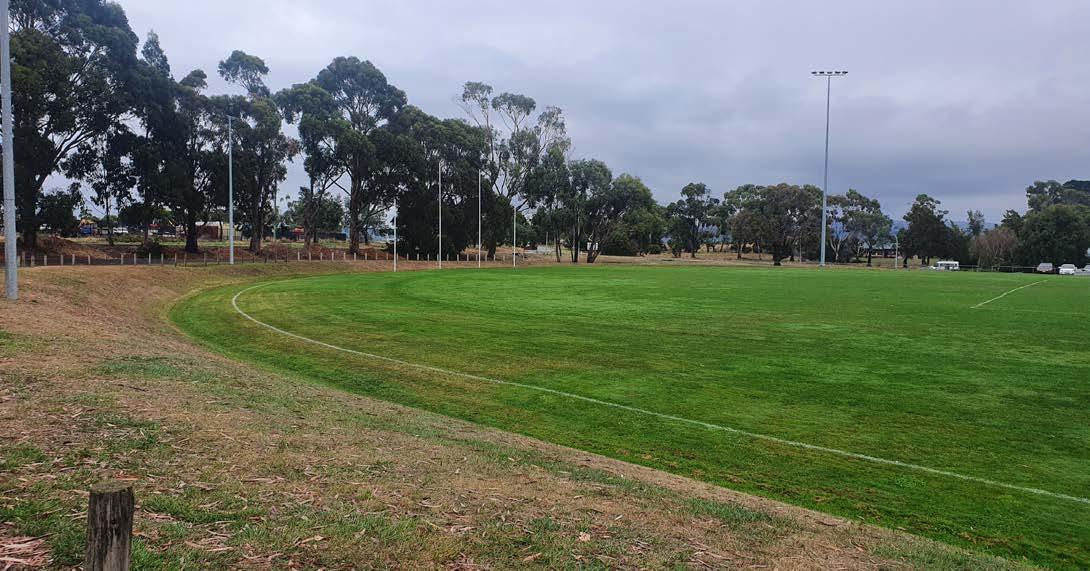
Lilydale Recreation Ground requires an upgrade to the entrance road and installation of spectator shade
the development of at least two new multi-oval facilities in key locations close to population centres potential for the Legana Structure Plan Growth Area as well as the growth area in the vicinity of St Leonards
City of Launceston to complete the master planning process for the NTCA precinct with the NTCA Facilities Management Group.
Running/Athletics is ranked 3rd in the top sports and physical activities participated in by Australian adults in 20221 and 9th for children.
Athletics is ranked the 4th highest sport participated in by Tasmanians for children, and the 2nd highest for Adults in 20221. It needs to be noted, however, that this ranking is inflated due to the inclusion of running activities (such as ParkRun) within ‘athletics’.

At a national level, participation in athletics is steady for children, and increasing for adults. At a state level, athletics is fluctuating for children, and increasing for adults. The increases in adult participation can largely be attributed to the popularity of ParkRun. Two local clubs have provided their participation numbers. (Whilst four clubs responded to the survey, two did not provide participation data).
There are 5 facilities catering for athletics within the study area. St Leonards Sports Centre - Northern Athletics Centre within the City of Launceston is the home of Athletics in the study area and is a state-level facility. Rocherlea Recreation Ground provides a regional-level facility, Windsor Community Precinct and Longford Recreation Ground are district-level facilities, and George Town Sports Complex provides local-level facilities. Meander Valley currently has no athletics provision.
A full list of facilities and their hierarchy by Local Government Area can be found within Appendix 2.
The existing facilities (with the exception of George Town Sports Complex) are in good condition. The George Town club utilise a local primary school for their training and compete at Rocherlea. Their training venue is in poor condition and is not suitable for their needs, albeit they have low membership.
The Northern Athletics Centre building and toilets are ageing and require an upgrade including gender-neutral facilities. The club has also identified a lack of seating and shade and a desire to upgrade the in-field area at Northern Athletics Centre. The club also highlights that the study area requires a grass oval to train - as the synthetic track is the sole place where the local clubs come to train.
The study area is well provided for with regards to the provision of athletics facilities, exceeding the preferred provision ratio of 1 facility per 75;000 residents. There is no evidence to suggest that the current provision is not meeting the requirements of the study area.

School facilities play an important role in providing facilities for athletics.
The centre of the St Leonards track provides an opportunity for winter sports to train given the availability of the field and the lights.
investigate inclusion of Little Athletics training facilities at the George Town Sports Complex re-development

undertake a master plan the Northern Athletics Centre and Northern Hockey Centre precinct to determine the future needs of both facilities, including potential upgrade of the building, toilets and in-field area
promote the availability of the centre of St Leonards track for winter sport to train
monitor the demand for additional facilities based on the growth of the sport (and population growth).
Badminton is ranked the 15th highest sport participated in by Tasmanians for adults in 20221 and is not ranked for children due to the very limited participation numbers.
At a national level, participation in badminton is steady for children and increasing for adults. At a state level, participation in badminton is very limited for children and decreasing for adults. One local club has provided their participation numbers.
Badminton is played at a number of indoor venues across the study area, including Graham Fairless Centre in George Town, Deloraine Community Complex, Beaconsfield Community Centre, Elphin Sports Centre, Westbury Indoor Sports Centre and the YMCA Launceston (albeit the uses at this facility are shifting).
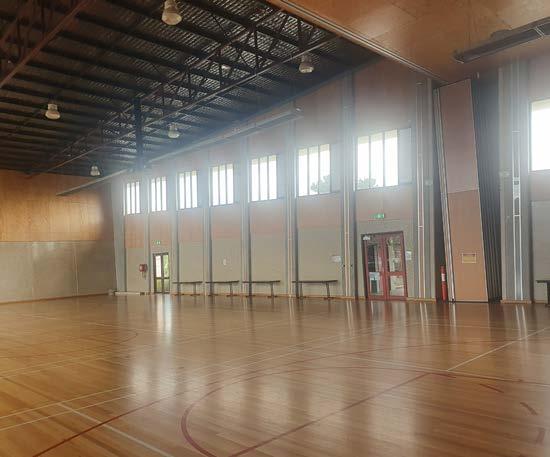
A full list of facilities and their hierarchy by Local Government Area can be found within Appendix 2.
The capacity of the existing venues across the study area is sufficient for the current and potential future participation in badminton. Participation in the sport is relatively low at a national, state and local level. There are ample indoor facilities available to meet both existing and projected future demand.
The Deloraine Association has identified that their facility is too cold during winter, as a result of no heating being available as well as the building being too draughty. They also have a desire for upgraded seating and additional storage within the venue.
Badminton Tasmania has a strategic objective to capitalise all opportunities to develop and maintain facilities for the sport. It seeks to maximise use of existing facilities to develop badminton, including to explore opportunities for shared space with like minded sports.
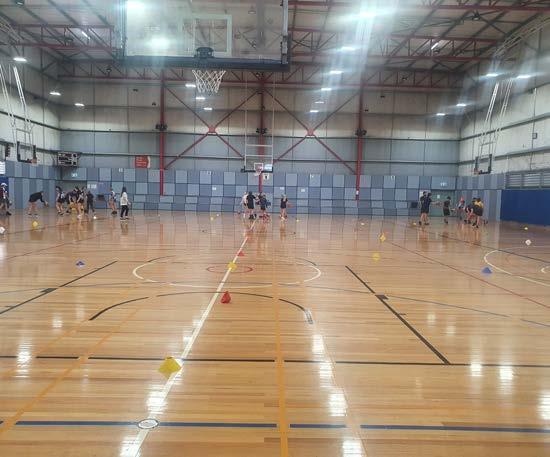
Supply of facilities currently out-weighs demand for facilities based on participation in Badminton. There is significant capacity within the study area to cater for future (un-planned) growth in the sport.
assess the suitability of the Deloraine Community Complex for badminton is recommended given the Association’s comments.
Baseball is ranked the 16th highest sport participated in by Tasmanians for children in 20221, and is not ranked for adults due to the negligible participation numbers.
At a national level, participation in baseball is steady for both children and adults. At a state level, baseball is decreasing for children, and negligible for adults. There is one local club, who have provided their participation numbers.
Churchill Park in Invermay is the sole baseball facility within the study area. The facility is shared with softball, over two diamonds. Baseball primarily use Diamond 2.
The study area is well provided for in regards to the provision of baseball (and softball) facilities. While the preferred provision ratio of 1 diamond per 50;000 residents is not being met, given the very low club membership there is no evidence to suggest that the current provision is not meeting the requirements of the study area. Participation in the sport is relatively low at a national, state and local level..
The club has a desire for their own facility, separate to softball. The club’s priorities include permanent seating, shade, lighting and toilet facilities. It is noted that the club have shared use of the Churchill Park facility and provision of additional toilets is not required. Additionally, lighting at the facility is currently suitable for the level of use at the facility.
Baseball Tasmania’s Strategic Plan (2021) has a goal for improved facilities and infrastructure, however, focusses specifically on the Glenorchy City Council area.
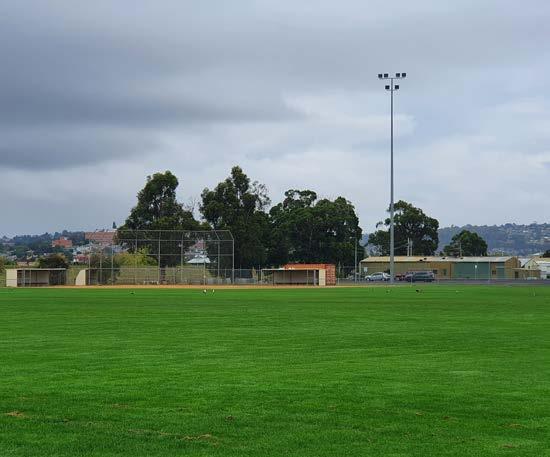

The club has a desire for their own facility. However, given their low membership numbers, this is not supported. Shared use facilities for complementary sports such as these will continue to be supported.
work with baseball and softball to improve shared use of the facility
install shaded seating for spectators.
Basketball is ranked 7th in the top sports and physical activities participated in by Australian adults in 20221 and 6th for children.
Basketball is ranked the 3rd highest sport participated in by Tasmanians for children and the 6th highest for adults in 20221 As the sport with the 2nd highest participation rate in the study area2, participation in basketball is projected to increase, particularly due to the success of the Tasmanian Jack Jumpers - an NBL team.
Participation in basketball at a national level for children is steady and increasing for adults. At a state level, basketball is increasing for both children and adults. Community survey results show basketball as the second highest participated sport, with 13% of respondents participating in the sport.
Basketball is emerging as a popular sport in Tasmania and participation in the study area reflects the ongoing popularity and growth of the sport. Basketball is projected to increase in the study area, particularly due to the success of the Tasmanian Jack Jumpers in recent years. Basketball Tasmania has provided their participation numbers for the North Region.
Table 17: Basketball club participation numbers
These figures are playing members only and exclude coaches, referees and school competition registrations.
Basketball within Northern Tasmania is focussed around Launceston, with Elphin Indoor Sports Centre providing 4 compliant courts with required run-offs. In addition to Elphin Sports Centre, the Longford Community Sports Centre provides one compliant court. The Silverdome provides 3 compliant courts, however are not consistently available for use by clubs.
A number of non-compliant indoor courts exist across the study area, including Graham Fairless Centre, Beaconsfield Community Centre, Legana Memorial Hall, Windsor Community Hall, Launceston PCYC, YMCA, Westbury Indoor Sports Centre, Meander Valley Performing Arts Centre and Deloraine Community Complex.

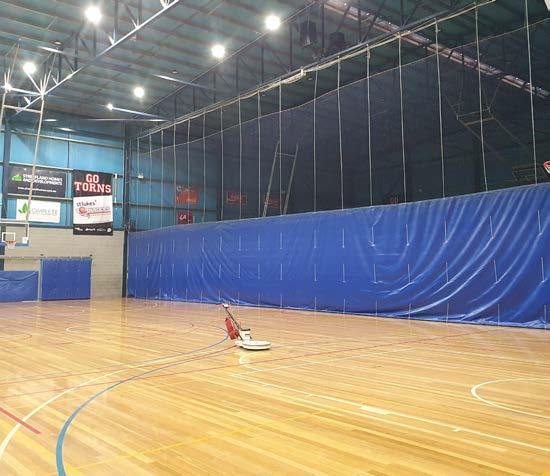
There are a number of school courts that provide community use across the study area (namely in the City of Launceston) including Launceston College, Newstead College, St Patrick’s College, Launceston Christian School, Scotch Oakburn College and Launceston Church Grammar School. These facilities are regularly used by clubs for training. Many of these facilities do not meet FIBA regulations, and (as private facilities) do not form part of this assessment.
A full list of facilities and their hierarchy by Local Government Area can be found within Appendix 2.
The demand for indoor courts far outweighs provision within the study area. Many of the existing courts do not meet minimum court size and run offs. Some competitions have fabricated byes as they are unable to run all teams due to lack of available court space. 1 Ausplay 2022 2 Northern Tasmania Sports Facility Plan Community Survey 2022
Regular fixtures are often displaced from large venues such as Elphin and the Silverdome, in favour of large events and trade shows.
The Longford Community Sports Centre has experienced high demand since its development. Its strong patronage coupled with the population growth in Longford, Perth and Evandale indicates the need to double the court at this facility to ensure the needs of the community are met.
There is a clear need for a dedicated multi-court venue that can provide a home to basketball within the study area. This facility would be supported by the existing venues.
The study area does not meet the preferred provision ratio of 1 court per 8,000 residents. There are currently 5 compliant courts compared to the required 17 in 2022 (based on population). This does not include the Silverdome due to its lack of regular availability. There is a predicted shortfall of 15 courts in line with population growth by 2036 (without additional development).
Basketball Tasmania’s strategic plan identifies a number of pillars and goal areas including the ‘Places to Play Strategy’. An action of the goal area is to develop a long-term facility strategy for basketball in Tasmania. This planning has yet to commence.
There is anecdotal evidence that climatic considerations such as extreme heat and cold, as well as unpredictable weather patterns are leading to an increased participation in indoor sports. Indoor facilities provide a consistent environment away from rain and allow for programming of training and fixtures without needing to avoid the peak heat of a day, or cold temperatures.
There is a lack of compliant, multi-court facilities within the study area for basketball.
The YMCA facility in Launceston is transitioning from its former management as a YMCA. Whilst not a compliant basketball facility, its two courts could enhance basketball capacity within the study area by re-directing other sports from the Elphin Indoor Sports Centre and freeing up valuable court space.

Initial concept plans for the Northern Suburbs Community Recreation Hub have been developed by the Tasmania Government which includes up to three indoor courts.
support the progression of the Northern Suburbs Community Recreation Hub concept plans in providing up to three purpose-built indoor courts
continue to pursue strategic investment opportunities including acquisitions, that deliver on the recommendations of the Plan, particularly those that build on and expand existing indoor facilities
identify a suitable location for the development of a future multi-court indoor facility to meet the growing needs of basketball
plan for the duplication of the Longford Community Sports Centre
investigate the re-location of table tennis and badminton from Elphin Indoor Sports Centre to free-up capacity for basketball.
BMX is ranked the 17th highest sport participated in by Tasmanians for children in 20221 and is not ranked for adults due to very limited participation numbers.
Participation in BMX at a national level for children is steady and increasing for adults. At a state level, BMX is largely uncaptured for both children and adults. One local club responded to the Club survey, and have confirmed they have 190 active members, ranging from 3 to 60 years old.
Bike riding, scooter riding and skateboarding are more popular activities for both young people and adults than a number of the more traditional formal sports. However, infrastructure (and resourcing) for these activities remains largely outweighed by formal sport.
The study area has one formal (club-based) BMX facility, located at the St Leonards Sports Centre. The facility provides for a high level of competition - hosting the Australian BMX Championships in 2022. This facility is supported by a number of locallevel active recreation facilities (for bikes, scooters and skateboards) including the newly-constructed Deloraine pump track, Westbury BMX track, Carrick BMX track, Hadspen BMX track, Legana BMX track and George Town pump track. There are gaps in the provision of pump tracks within the Northern Midlands and City of Launceston LGA’s. It is acknowledged that a BMX track and a pump track are two distinct infrastructure types and provide different riding opportunities.

Facility provision for BMX across the study area meets the current participation levels and demand for the sport. The supporting facilities are ageing and require upgrades to improve year-round spectator viewing, as well as improved lighting. There is a need for additional active recreation facilities such as pump tracks within the City of Launceston and Northern Midlands to provide further opportunities for informal active recreation.
Bike riding and scootering for recreation (rather than BMX as a formal sport) are some of the more popular activities for young people across Tasmania.
undertake a master plan the St Leonard Sports precinct including BMX, hockey, athletics and croquet to determine the future needs of the facilities, including potential upgrade of the building, toilets and in-field area

consider ancillary facility upgrades including provision of spectator viewing and improved lighting
monitor the demand for additional formal BMX facilities across the study area in line with population growth
consider the development of pump tracks within the Northern Midlands and City of Launceston to enhance the provision of active recreation across the study area.
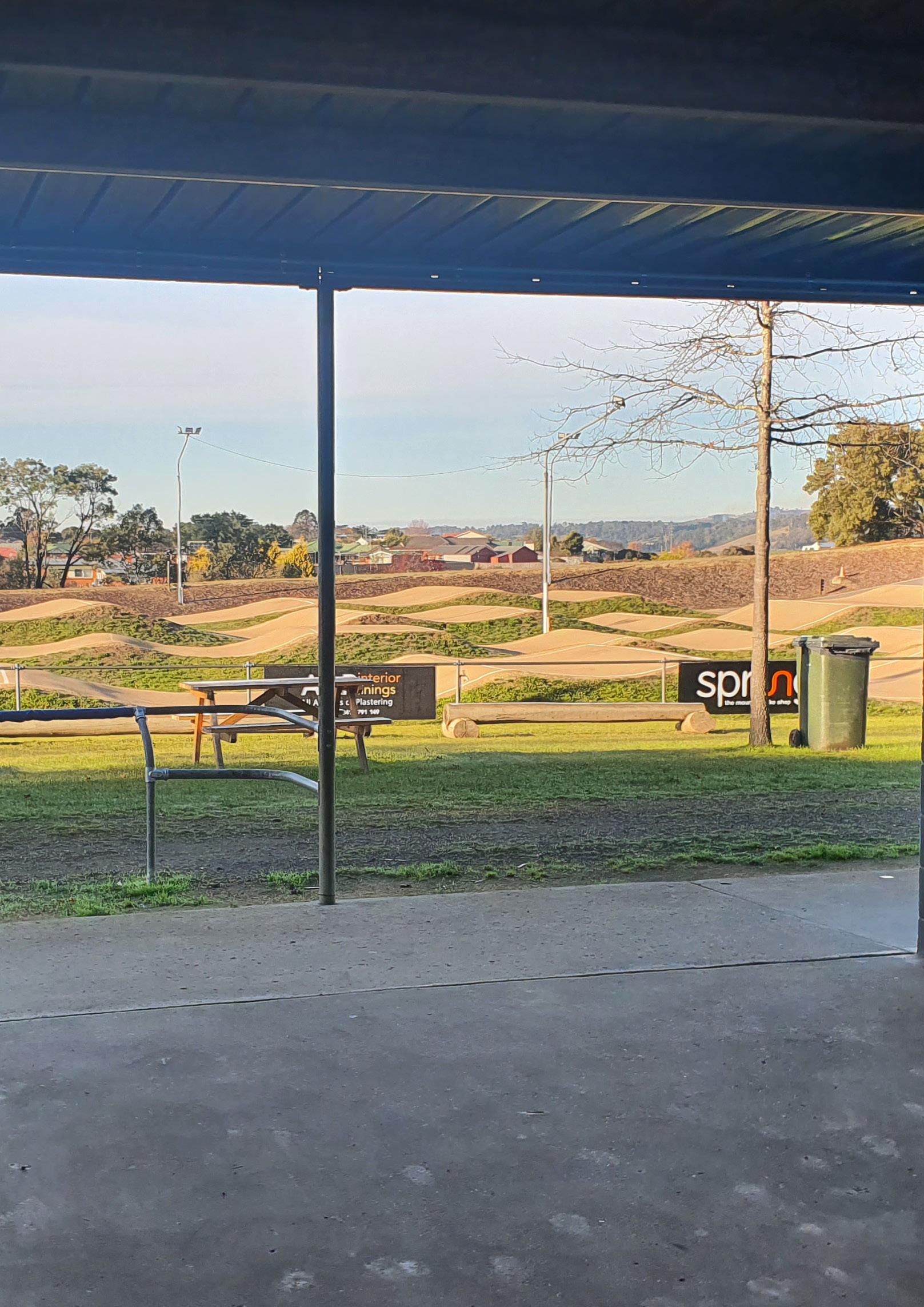
Cricket is ranked 10th in the top sports and physical activities participated in by Australian children in 20221, however, is outside of the top 10 for adults.
Cricket is ranked the 7th highest sport participated in by Tasmanians for children and the 10th highest for adults in 20221. Cricket has the 3rd highest participation rate (equal with AFL) in the study area2
Participation in cricket at a national level for children is decreasing and is steady for adults. Reflecting the national trends, at a state level, cricket is decreasing for children and is steady for adults. Nine local clubs provided membership data, with summed totals included below.
Cricket has access to more than 34 ovals across the Northern Tasmania study area. A number of these ovals are shared facilities with AFL. These facilities include:
a national-level stadium, UTAS stadium in Launceston
regional-level facilities such as the NTCA sportsgrounds in Launceston, Windsor Community Precinct, Longford Recreation Ground and Morven Park Recreation Ground. Windsor Park and the NTCA are the only two facilities with indoor training nets for cricket within the study area
district-level facilities including George Town Cricket Oval, Youngtown Oval, Churchill Park and Bridgenorth Recreation Ground
a large number of local-level facilities including Ross Recreation Ground, Perth Recreation Ground, West Arm Recreation Ground, Legana Recreation Ground, Fysh Street Recreation Ground, Weymouth Sports Ground, Bellingham Sports Oval, Pipers River Recreation Ground, Lebrina Recreation Ground, Karoola Recreation Ground, Trevallyn Park, Deloraine Recreation Ground, Hagley Recreation Ground, Whitemore Recreation Ground, Carrick Memorial Recreation Ground and Hadspen Recreation Ground
in addition, there are a handful of informal facilities within the City of Launceston that could provide training venues including Dover Reserve, Newstead Reserve and Charlton Street Reserve.


In addition to these ovals, there are two indoor cricket training venues across the study area, including Windsor Community Precinct and the NTCA.
A full list of facilities and their hierarchy by Local Government Area can be found within Appendix 2.
There are very few multi-field facilities within the study area. George Town Sports Complex, Churchill Park and Windsor Community Precinct are the only facilities offering multiple ovals; George Town has 2 and an additional junior oval, and Windsor Park has 3 ovals for cricket. Irrigation and drainage improvement works are currently being undertaken at George Town.
In addition to the lack of multi-field facilities, there are very few opportunities for training besides the main field at each facility.
Playing surfaces are generally in good condition at the commencement of the season across the study area. Due to the availability of only single-field facilities for both training and competition, by the end of the season the fields are in poor condition due to over-use and a lack of formal drainage. Run-ups become worn toward the end of each playing season.
The study area currently meets the preferred provision ratio of 1 oval per 4,000 residents. With the projected population, an additional oval will be required from 2026, and an additional 6 to meet expected demand by 2036.
There is a need to confirm the need for a number of identified facilities, which appear to have no formal cricket use, including Lebrina Recreation Ground and Karoola Recreation Ground. Beechford Recreation Area is an isolated facility with no surveillance. The oval is in poor condition and would be unsafe for players in its current condition.
Bellingham Sports Oval is in poor condition and appears to be used as a golf course. The field is uneven and would be unsafe for cricket in its current condition. There is no evidence of use for cricket.
The Ross Recreation Ground has recently been adopted as the state head quarters for Veterans Cricket Tasmania which is seeing the facility attract increased use. The existing clubhouse is in need of upgrade to cater for the use, as well as provide gender-neutral facilities.
The Perth Recreation Ground has been earmarked for re-location due to the likely need for this land for the expansion of the adjoining school.
Diggers Cricket Club has identified that the Hagley Recreation Ground is in need of an additional shaded area for players and spectators, upgraded visitor change rooms as well as provision of cricket practice nets. The lack of nets means the club are training at a local school rather than their home facility
Launceston Cricket Club has identified that the training facilities at NTCA are inadequate to cater for the numbers from each club based at the complex. The facility is at-capacity, however the club continues to grow across all cohorts. The club has a desire for improved access to a club room for storing memorabilia and hosting functions. There is a need for femalefriendly or at least gender-neutral facilities
Legana Cricket Club report being too large for the facility at the Legana Recreation Ground. The club rooms and change facilities are too small and in need of female-friendly or gender-neutral change facilities. The club has a desire for an upgraded kitchen to allow a functioning kiosk, as well as provision of additional storage. The club would like an additional practice net to improve capacity at training
Riverside Cricket Club at Windsor Community Precinct require separate female change rooms and have a desire for seating in front of the change rooms
South Launceston Cricket Club at NTCA have no dedicated female change rooms or showers. There are insufficient practice nets available for training given the size of the club
Veterans Cricket Tasmania at Ross Recreation Ground have identified the need for gender-neutral or female-friendly facilities. Shade for both players and spectators is also needed. The oval requires irrigation and re-surfacing to improve the quality of the playing surface. There is a desire to expand the turf wicket from a 3- to a 5-wicket square to enable the facility to cope with additional matches
Westbury Shamrocks Cricket Club located at Westbury Recreation Ground has identified the need for separate female change facilities as well as an indoor training area. They have a desire for improved shaded seating for players outside the change rooms and a larger storage area.
there are a number of outdated toilet and change facilities across the study area, that do not cater for gender diversity in the sport
a number of venues are either currently at or over-capacity, with too many home teams and large club numbers. Access to practice nets for training is also an issue
a number of clubs have identified spectator seating and shade as not suitable
there is a lack of indoor training facilities across the study area, allowing for all weather use, and improved programming for users
a need exists for multiple-oval facilities to enhance capacity and reduce pressure on playing surfaces.
continue to pursue strategic investment opportunities including acquisitions, that deliver on the recommendations of the Plan, particularly those that build on and expand existing cricket facilities
develop multiple oval facilities to enhance capacity and reduce pressure on playing surfaces - potential for Deloraine Recreation Ground (Racecourse)

City of Launceston to complete the master planning process of the NTCA precinct with the NTCA Facilities Management Group
formalise the use of Dover Reserve, Newstead Reserve and Charlton Reserve for training to take the pressure off other venues
confirm the use of Lebrina Recreation Ground, Karoola Recreation Ground and Bellingham Sports Oval for cricket
undertake a Master Plan and Facility Management Review of Trevallyn Park (cricket, tennis and lawn bowls) including car parking and circulation
upgrade the clubroom and change facilities at Ross Recreation Ground to cater for its increased use. There is a need to install an irrigation system and resurface the oval.

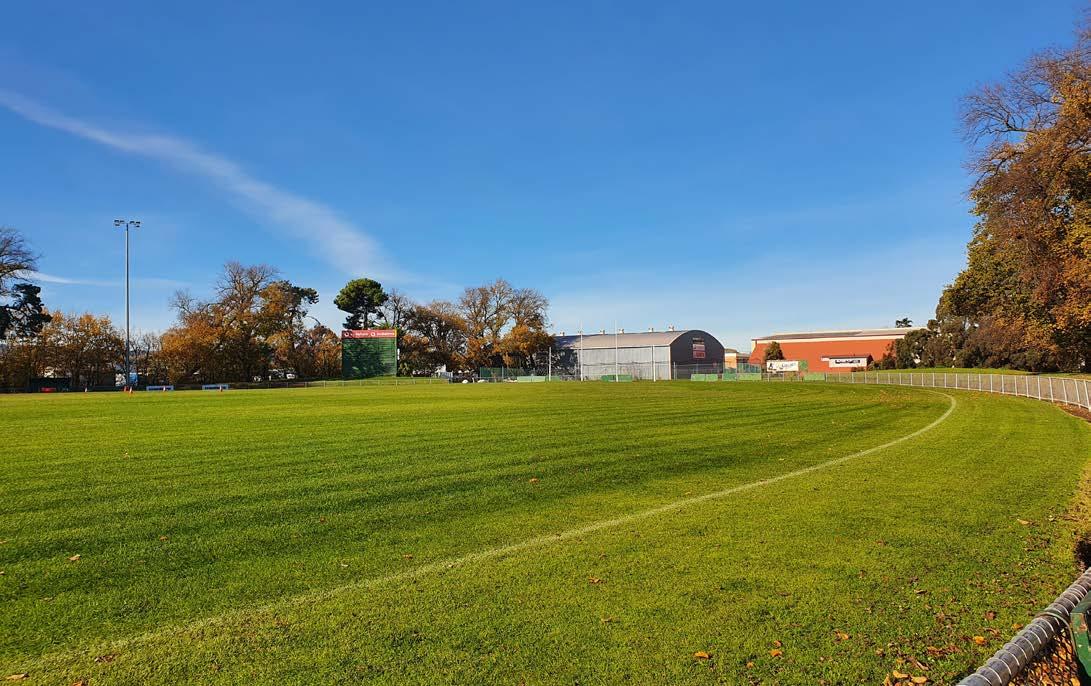
Participation in croquet at a national level is very limited for children and increasing for adults. At a state level, croquet participation is very limited for children and steady for adults. Four local clubs provided membership data that is totalled below.
The City of Launceston is the home of croquet within the study area with 3 facilities. The East Launceston Croquet Club, Northern Tasmania Croquet Centre at St Leonards and Royal Park in Launceston. George Town Community Bowls Club also provides croquet facilities. The other 3 local government areas have no Council-owned or managed- provision of croquet facilities.
Facilities range from a local-level facility (East Launceston Croquet Club with one lawn), to district-level facilities at George Town and Royal Park, to a regional-level facility at the Northern Tasmania Croquet Centre with eight full size croquet lawns.
A full list of facilities and their hierarchy by Local Government Area can be found within Appendix 2.
Existing facility carrying capacity
Croquet is a relatively low participation sport at a National and state level. Local participation is consistent with national and state trends. The facility provision for croquet across the study area appears to meet the current participation levels and expected demand for the sport.
East Launceston Croquet Club has a desire for an additional lawn to be developed on the adjacent disused tennis courts. The club’s membership is capped because they have only one lawn. This proposal is at odds with the East Launceston Bowling Club whom also have a desire to utilise the derelict tennis courts to develop an under-cover synthetic green. The croquet club also have a desire for an expanded clubhouse including the development of an all-access toilet facility.
the clubs at the Northern Tasmania Croquet Centre have noted insufficient toilets, and have a desire for an expansion to their clubhouse to provide additional space whilst hosting large tournaments and pennants.
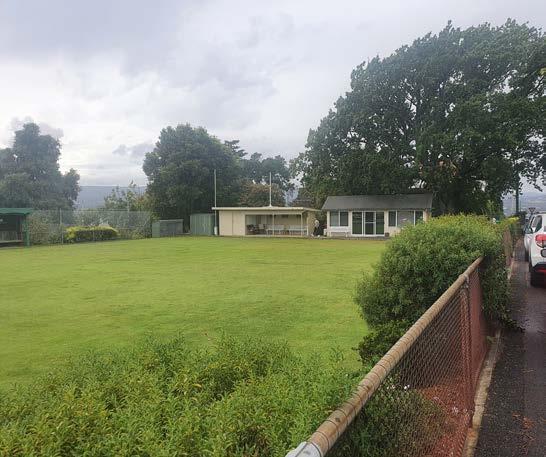
George Town Bowling Club currently has shared use between croquet and lawn bowls. The club has a desire to develop a separate croquet lawn to cater for croquet. The site appears too small to accommodate this additional lawn within its current footprint. The club also have a desire to expand their clubhouse to provide additional toilets and change facilities as well as an upgrade to their kitchen and hall.
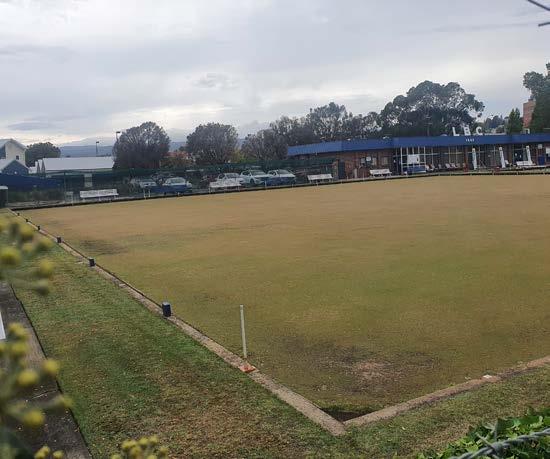
Due to the low participation in the sport and the high concentration of facilities within Launceston, it is recommended that no new facilities be developed. Councils should continue to support existing clubs with appropriate improvements in line with the level of facility, including:
the East Launceston Croquet Club and City of Launceston to work together in undertaking an accessibility audit and developing a preferred site layout for the future of the facility, which includes the needs of the East Launceston Bowling Club
investigate the feasibility of converting the disused tennis courts at East Launceston Croquet Club to a shared facility between croquet and bowls
as part of the master planning process of the St Leonards Sports Complex (athletics, hockey, BMX and croquet), include the Northern Tasmania Croquet Centre and work with clubs to implement facility sharing.
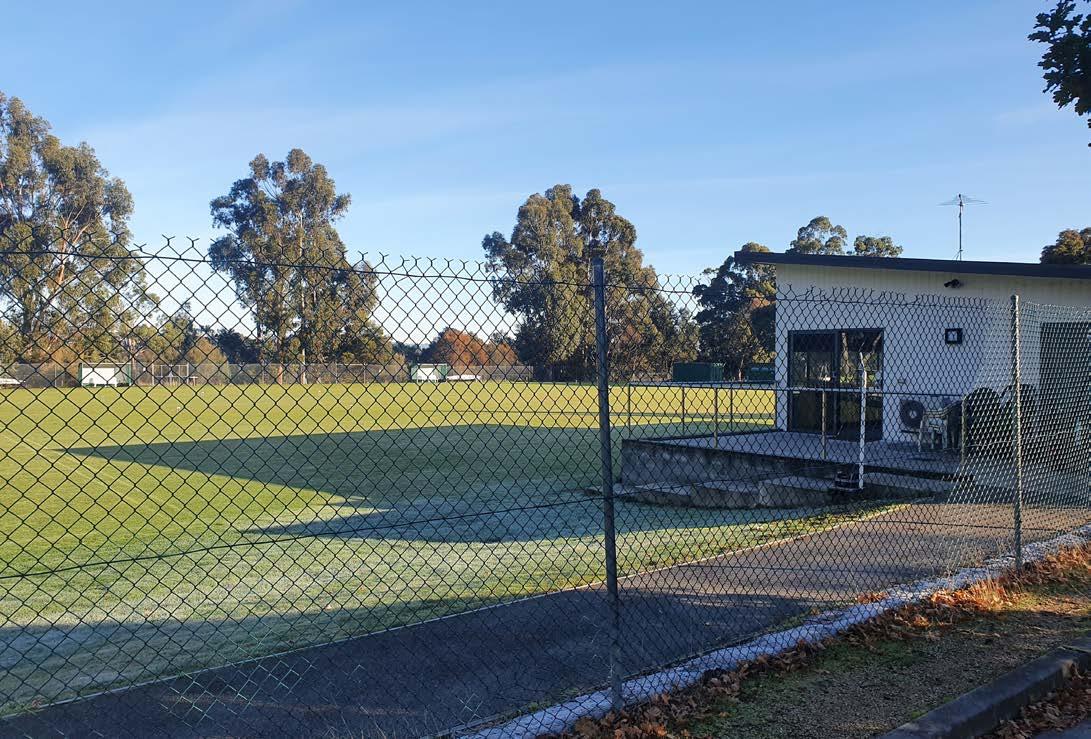
Cycling is ranked 5th in the top sports and physical activities participated in by Australian adults in 20221, however is ranked outside of the top 10 activities for children.
Cycling is ranked the 17th highest sport participated in by Tasmanians for children and the 3rd highest for adults in 20221.
Participation in cycling at a national level is increasing for both children and adults. At a state level, cycling participation is largely uncaptured for children and steady for adults. No participation data has been provided by local clubs.
There are two outdoor formal cycling tracks and one indoor facility within the study area. The newly developed Longford Velodrome is a regional facility and the George Town Sports Complex is a district facility. The Silverdome provides an indoor cycling track.
A full list of facilities and their hierarchy by Local Government Area can be found within Appendix 2.
The facility provision for track cycling across the study area appears to meet the current participation levels and potential future demand for the sport.
The George Town criterium track is in reasonable condition however the fencing and adjoining spectator shelters are ageing and in need of replacement.

The newly developed velodrome at Longford is likely to increase participation in the sport, through provision of a safe, modern cycling facility, and through increased visibility of the sport in the study area. Additionally, with the improvement of the George Town track, cycling within the study area is likely to see a further increase in participation, due to an anticipated latent demand.

continue to monitor demand for off-road cycling and additional facilities across the study area in line with population growth and demand for the sport
program the replacement of the George Town fence and spectator shelters, as well as improvements to the track surface.
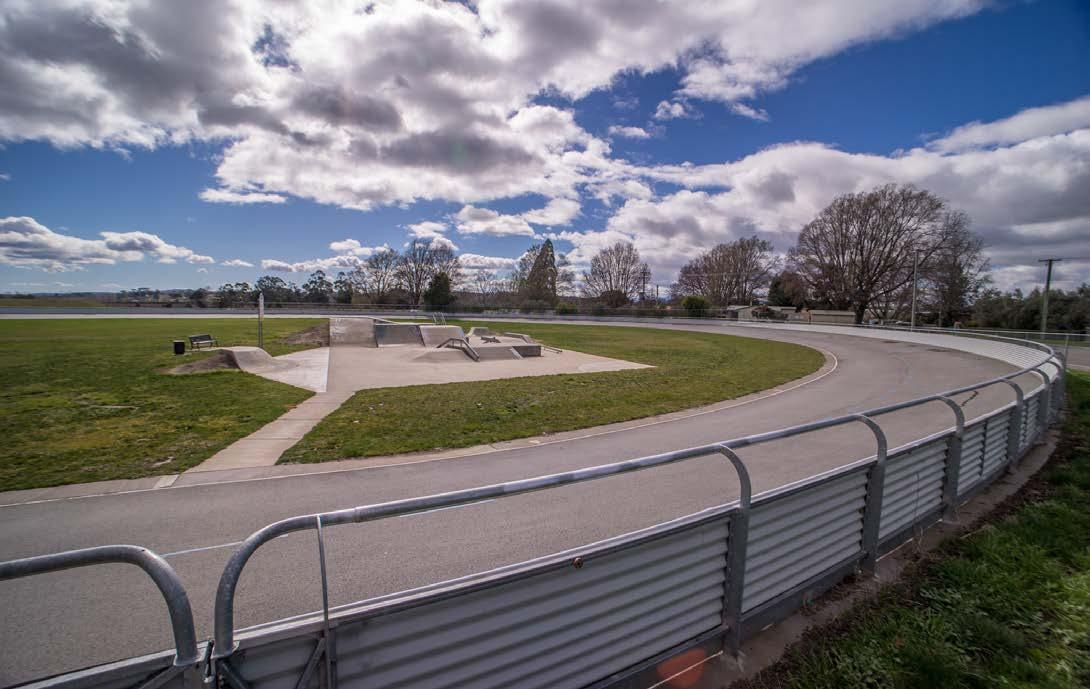

Equestrian is ranked the 14th highest sport participated in by Tasmanians for children and the 10th highest for adults in 20221
Participation in equestrian at a national level is increasing for both children and adults. At a state level, participation in equestrian sports is largely uncaptured for children, and decreasing for adults. Membership data has been provided by Equestrian Tasmania for the Northern region.
There is a good distribution of equestrian facilities across the study area, with 6 known facilities that are council-owned or controlled. These include local-level facilities such as Lebrina Recreation Ground, Karoola Recreation Ground and Beaconsfield Grubb Street Recreation Ground; district-level facilities such as Ross Recreation Ground and Longford Showground; and a regional-level facility -Edinburgh Park at Gravelly Beach. Additionally, there are a number of private facilities across the study area including Faulkner Park (Launceston Church Grammar School.

A full list of known facilities and their hierarchy by Local Government Area can be found within Appendix 2 (this excludes private facilities).
The current provision of facilities in the study area appears to be in line with membership numbers and subsequent demand for facilities.
The Western Performance Club of Tasmania located at Edinburgh Park has a desire for expansion of their facilities including larger arenas, covered yards and shade areas for spectators. They require larger arenas as existing arenas are currently too small for western events.
The Lebrina Equestrian Club shares the Lebrina Recreation Ground with cricket. There appears to be very little formal use of the site by cricket.
The Lilydale District Pony Club shares the Karoola Recreation Ground with cricket. There appears to be very little formal use of the site by cricket.
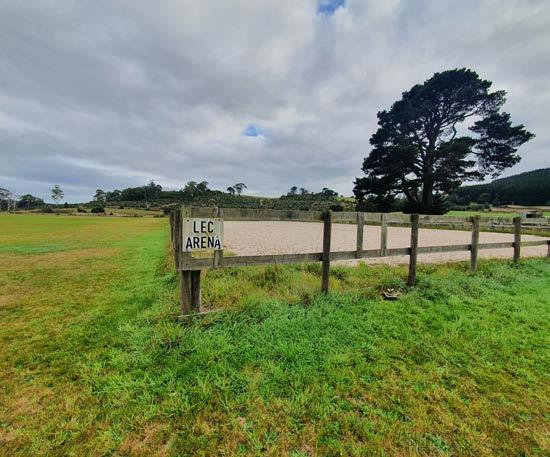
A submission was received from Pony Club Tasmania seeking support for the development of a Northern Tasmania Equestrian Centre on to be developed on a 50ha site. The proposed facility would include an indoor arena, multiple outdoor arenas, fields and a cross country course. There is a need to confirm membership data for equestrian clubs within the study area to assist in the assessment of the proposal.
Southern Tasmania is currently home to the Tasmanian State Equestrian Centre. There is no equivalent facility in the north of the state. However, this southern facility is only a 2.5 hour drive from Launceston - largely accessible by the majority of Tasmanians.
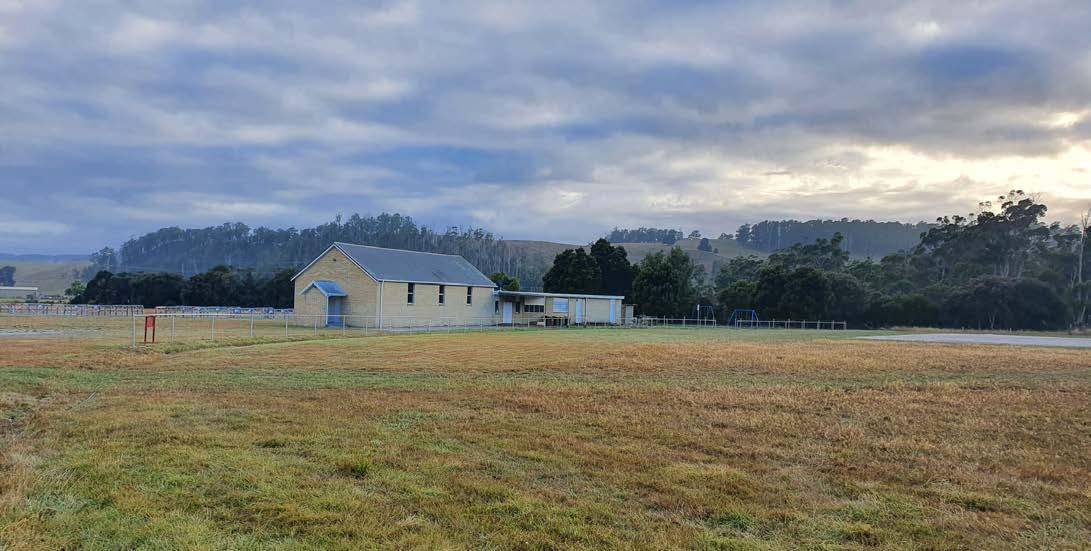
Tasracing and the Northern Midlands Council have recently undertaken a master plan of the Longford Racecourse to expand the site to cater for alternate equestrian activities. The vision of the master plan is to become the home of equestrian events in Northern Tasmania. The plan includes an international size polo field, four large pavilions for equine use, an undercover equestrian centre with 50 x 70m sand ring, up to 84 stables and day yards and an equine pool, bullring, treadmill and sand walking arena.
Acknowledging the various equestrian disciplines, there is a need for the clubs in the north to come together with Equestrian Tasmania to create a visioning statement about what the future of equestrian looks like in the north of the state.
investigate the demand for cricket at Lebrina Recreation Ground. If there is no demand for cricket, there is the potential for equestrian uses to expand
investigate the potential for Edinburgh Park to be expanded to include an expanded outdoor arenas and covered yards
Equestrian Tasmania in conjunction with the clubs located within Northern Tasmania, undertake a strategic review of their facilities in the north
the Northern Tasmania area, should focus its efforts on one key higher order facility capable of developing an undercover equestrian centre/indoor arena. The current and projected participation in equestrian sports is not capable of supporting a number of duplicate facilities.
Football is ranked 8th in the top sports and physical activities participated in by Australian adults in 20221 and 2nd for children.
Football is ranked the 5th highest sport participated in by Tasmanians for children and the 4th highest for adults in 20221 Football has the 4th highest participation rate in the study area2.
With 2022 a World Cup year (and Australia qualifying for the final 32 teams), the sport is expected to see an increase in participation. With Australia co-hosting the 2023 Women’s World Cup (and Australia ranked to compete strongly), a further jump in female participation is likely. Female participation is already increasing locally which will only strengthen in moving forward.
Participation in football at a national level for children is steady and increasing for adults. At a state level, football is steady for children and increasing for adults. Three local clubs provided their membership data (four clubs responded to the survey).
There are over 20 football fields within the study area (with the City of Launceston hosting half of these). The City of Launceston also has a number of informal (active recreation) facilities including Coronation Park and West Launceston Community Park that attract football use.
district-level facilities across the study area include Birch Avenue Soccer Grounds, Carrick Memorial Ground, Windsor Community Precinct and NTCA Sportsgrounds (each with at least 2 fields).
Churchill Park Sports Complex and Prospect Vale Community Park are the two regional-level facilities within the study area.
local facilities include the George Town Sports Complex.
additionally, there are a couple of informal fields within the City of Launceston that could be formalised for training to take the pressure off other facilities, including Coronation Park and West Launceston Community Park.


a number of school fields are also utilised by sports clubs within the Study Area. A full list of facilities and their hierarchy by Local Government Area can be found within Appendix 2.
Playing surfaces are generally in good condition especially at the two regional-level facilities. The study area lacks multiple-field facilities, as well as dedicated football facilities that allow extended use during the pre-season, as well as access to training facilities. Pre-season use of fields that are shared with other codes is generally limited or non-existent. Carrick Recreation Ground is under-utilised and provides an opportunity as a training facility for soccer and other sports.
The study area does not currently meet the preferred provision ratio of 1 field per 5,000 residents. There are currently 20 fields compared to the required 27 in 2022. There is a predicted shortfall of 13 fields in line with population growth by 2036 (assuming no additional fields are developed).
1 Ausplay 2022
2
Northern Tasmania Sports Facility Plan Community Survey 2022
Due to increasing participation in football, particularly by children and women, it is expected that additional facilities will be required in the coming years.
Football Federation Tasmania (FFT) has identified a key priority project in Launceston - the development of a synthetic pitch. This facility would be a dedicated playing facility that can be the home of football in Northern Tasmania. Churchill Park has been identified as the preferred location for this potential project.
FFT has also identified that the Launceston City Football Club (Prospect Vale) requires upgraded change rooms, and the Northern Rangers located at NTCA require improved spectator facilities.
FFT recently undertook a state-wide infrastructure audit that identified many teams do not have regular, consistent or sufficient access to grounds.
These directives are consistent with the feedback received from local clubs.
Launceston City Football Club require an upgrade to their amenities, including additional change rooms (and female-friendly options) to cater for the volume of participants. These facilities are not council-managed, rather they are leased from the Australian Italian Club.
School facilities are regularly used for training. However, issues include alack of suitable access to toilets and change rooms, no lighting, poor (or no) linemarking and inconsistent access to goal nets.
Clubs need access to pitches year round (approx 40 weeks of the year) as football is no longer purely a winter sport. In fact, Football Federation Australia has worked hard to encourage year-round options for football - such that field sharing is near-to impossible.
The NTCA limit use of the fields for soccer from April to August. However, the fields are required for much longer than this to meet demand for pre-season and representative training.
The Riverside Olympic Football Club at Windsor Community Precinct have highlighted the need to improve the quality and drainage of the fields outside of the main pitch. An upgrade of the training lights to LED would be advantageous.
West Launceston Community Park is currently an informal facility, which with some improvements could provide a suitable training facility for Football. The field is in poor condition, as are the public toilets. The facility currently has no lighting.
continue to pursue strategic investment opportunities including acquisitions, that deliver on the recommendations of the Plan, particularly those that build on and expand existing football facilities
investigate suitable land for the development of a new multi-field facility for football within the study area. There is potential for this facility to be located within the growth area near to St Leonards or Legana. The development of a synthetic pitch should be considered at this location
City of Launceston to complete the master planning process of the NTCA precinct with the NTCA Facilities Management Group
master plan the greater NTCA/Elphin Indoor Sports/Tennis World precinct to improve car parking, access, circulation, rationalise some uses and provide opportunities to expand uses where practical
upgrade the West Launceston Community Park to provide an additional training facility for Football. Lighting and field upgrade would be required in the first instance, with future upgrades to the existing public toilets
encourage the use of Carrick Recreation Ground for training for soccer and other sports
investigate the need for a football field within the north of the Northern Midlands Local Government Area.
Gymnastics is ranked 3rd in the top sports and physical activities participated in by Australian children in 20221, however, is ranked outside of the top 10 for adults.
Gymnastics is ranked the 5th highest sport participated in by Tasmanians for children and the 20th highest for adults in 20221.
Participation in gymnastics at a national level is increasing for children and is steady for adults. At a state level, gymnastics is steady for both children and adults. Gymnastics Tasmania has provided participation numbers for the two clubs within the study area:
The Northern Tasmania study area has two gymnastics clubs, PCYC Launceston and West Tamar Gymnastics in Exeter. Both clubs operate out of private facilities.
The capacity of the two clubs at their existing venues are unknown. However, PCYC Launceston has identified that they may relocate in the future - to a larger facility that may increase capacity for its current and future users.
Gymnastics Tasmania’s North Region (West Tamar, Break O’Day, Dorset, George Town, Meander Valley, Launceston and Northern Midlands) is serviced by two clubs and has the lowest participation rate in the state.
Gymnastics Tasmania’s Facilities Strategy outlines in its strategic objectives to work with LGA’s in the region to ensure there is provision for gymnastics in future sport and recreation facilities. It also has a directive to develop a business case to establish a second gymnastics facility in Launceston.
Due to the (generally) exclusive nature of a gymnastics facility (e.g. permanent equipment set-up), venues are often privately owned and operated.
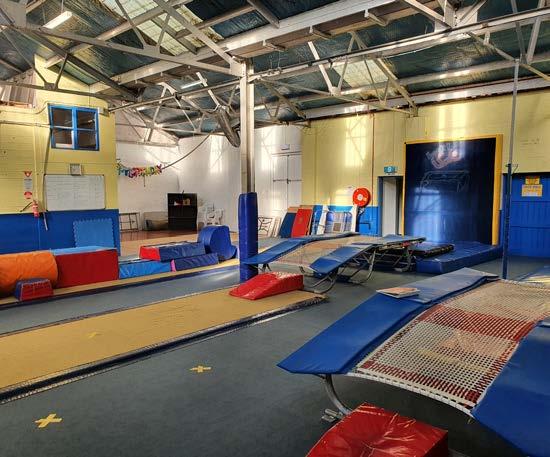

support the progression of the Northern Suburbs Community Recreation Hub concept plans in potentially providing shared use of an indoor facility
monitor demand for gymnastics within the study area and support clubs in seeking access to existing indoor venues where appropriate.
Hockey is ranked the 8th highest sport participated in by Tasmanians for children and the 13th highest for adults in 20221
Participation in hockey at a national level for children is decreasing and is steady for adults. At a state level, hockey participation is fluctuating for children and increasing for adults. Hockey Tasmania has provided membership data for the local clubs within the North Region:
The Northern Hockey Centre at St Leonards is the home of hockey within the study area and with two synthetic fields, is the hub for high-level competition and events. There are four hockey clubs based in Launceston, as well as three school teams within the junior competition. In addition to the Northern Hockey facility, grass facilities exist within a number of local schools.
The Northern Hockey Centre is home to the Greater Northern League played among clubs from across the North-West Coast and Northern Tasmania regions. Approximately 1,500 players and spectators attend the Centre each week during the hockey season.
The study area currently meets the preferred provision ratio of 1 field per 90,000 residents. With the projected population, the existing supply of fields is sufficient to 2036.
A full list of facilities and their hierarchy by Local Government Area can be found within Appendix 2.
Hockey Tasmania have a priority action to increase junior numbers in Launceston. They also have a desire to complete a future development plan for facilities, and develop a promotional plan to ensure maximum utilisation of all facilities.
Hockey Tasmania have a plan to re-develop the Northern Hockey Centre at a cost of approximately $2 million. They are seeking government support in the form of funding to see the upgrade achieved.
The current supply of facilities is suitable for the current level of participation in hockey, and will likely cater for future population growth.
undertake a master plan of the St Leonards Sports Complex including hockey, athletics, BMX and croquet to determine the future needs of all facilities
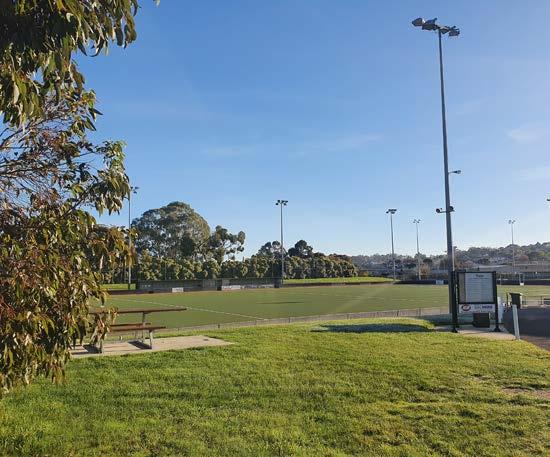
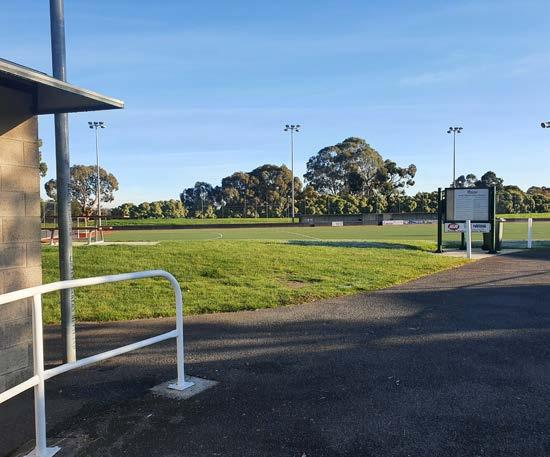
in line with the outcomes of the master planning process, prioritise the building facility upgrades at the Northern Hockey Centre to enable major events to continue to occur
monitor demand in line with future participation patterns and population growth.


Lawn bowls is ranked the 10th highest sport participated in by Tasmanians for adults and is not ranked for children in 20221 due to the very limited participation numbers.
Formal (or registered) playing membership of bowls clubs in Australia has been decreasing for more than 30 years at the rate of 3.4% per annum on average. Social bowls has become the major area of participation in recent years. It is now established as, by far, the largest participation segment in bowls2
Participation in lawn bowls at a national level is increasing for adults, whilst participation by children is very limited. At a state level, lawn bowls participation is very limited for children and decreasing for adults. Three local bowls clubs provided membership data, with data summed in the table below.
There are 33 outdoor lawn bowling greens across the study area and one indoor green. More than half of these greens are located within the City of Launceston alone.
The study area has a number of synthetic greens, including; Longford Bowls Club, Westbury Bowls Club, George Town Community Bowls Club, Royal Park Bowls Club and East Launceston Bowls Club. Trevallyn Bowls and Community Club is the only facility with more than 2 outdoor greens. Kings Meadows Bowls Club has 2 outdoor greens and has the only indoor bowls facility (synthetic) within the study area. The West Launceston Bowls and Community Club have the only lit green.
A full list of facilities and their hierarchy by Local Government Area can be found within Appendix 2.
The supply of facilities currently outweighs demand for facilities based on participation in lawn bowls. There is significant capacity within the study area to cater for future growth in the sport. However, growth this is unlikely given the local, state and national trends for the sport.
The study area currently has an over-supply of facilities based on the preferred provision ratio of 1 green per 15,000 residents. There are currently 33 greens (not including indoor greens) compared to the required 9 in 2022. Even considering the predicted population growth within the study area, there will still be an over-supply of 23 greens in 2036.
The continued decline in playing memberships coupled with a lack of volunteers is leading to a number of clubs who are struggling to maintain their facility. Yet, a number of clubs have a desire for ‘bigger and better ’facilities such as lights, synthetic surfaces, indoor greens and additional greens to host high level competitions, some without the membership base to support the improvements.
West Launceston Lawn Bowls Club has a desire to develop one of their existing greens to synthetic surface to allow for yearround use. The club is also seeking an upgrade to their lighting and installation of shade structures for spectators

East Launceston Bowling Club has a desire to develop an undercover synthetic green over the two derelict tennis courts that adjoin their site. This proposal is at odds with the East Launceston Croquet Club that also has a desire to utilise the derelict tennis courts to develop a second lawn. (Additional lawn bowls development is also not recommended due to the existing significant over-supply of lawn bowls facilities within the study area)
George Town Community Bowls Club currently has greens that are shared between croquet and lawn bowls. The club has a desire to develop a separate croquet lawn to cater for the sport to reduce the disruption on bowls. However, the site is too small to accommodate this additional lawn within its current footprint. The club also has a desire to expand their clubhouse to provide additional toilets and change facilities as well as an upgrade to their kitchen and hall. An upgrade to their existing facilities is supported however an expansion is thought to be beyond the capacity of their membership.
undertake a Lawn Bowls rationalisation strategy across the study area (particularly focussing on the City of Launceston) to determine the viability of the existing clubs and determine a future program of upgrades, consolidation and potential divestment
master plan the greater Trevallyn Park site to improve car parking, access and circulation.
Martial Arts participation
Martial arts is ranked the 10th highest sport participated in by Tasmanians for both children and adults in 20221
Participation in martial arts at a national level is steady for both adults and children. At a state level, martial arts is increasing for children and is steady for adults. No local clubs provided membership data (one club responded to the club survey).
Existing facilities
While a number of clubs operate out of private facilities or informally within community venues, there is only one club that has a dedicated venue within a council-owned or -controlled facility. The Brazilian Jiu-Jitsu Academy operates out of Elphin Indoor Sports Centre.

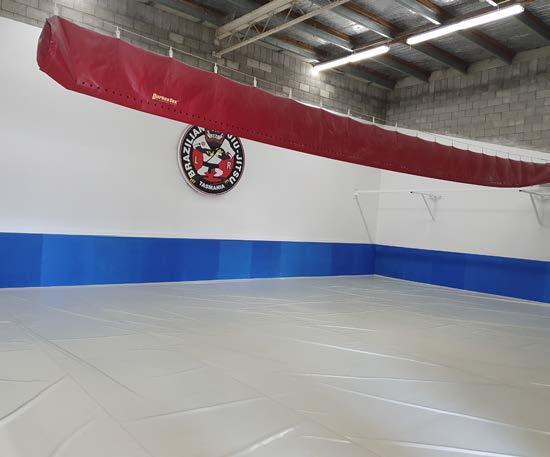
Existing facility carrying capacity
Supply of suitable indoor facilities currently out-weighs demand for facilities based on participation in martial arts. There is significant capacity within the study area to cater for future growth in the sport.
Recommendation
support existing and emerging clubs in finding suitable venues within the study area.
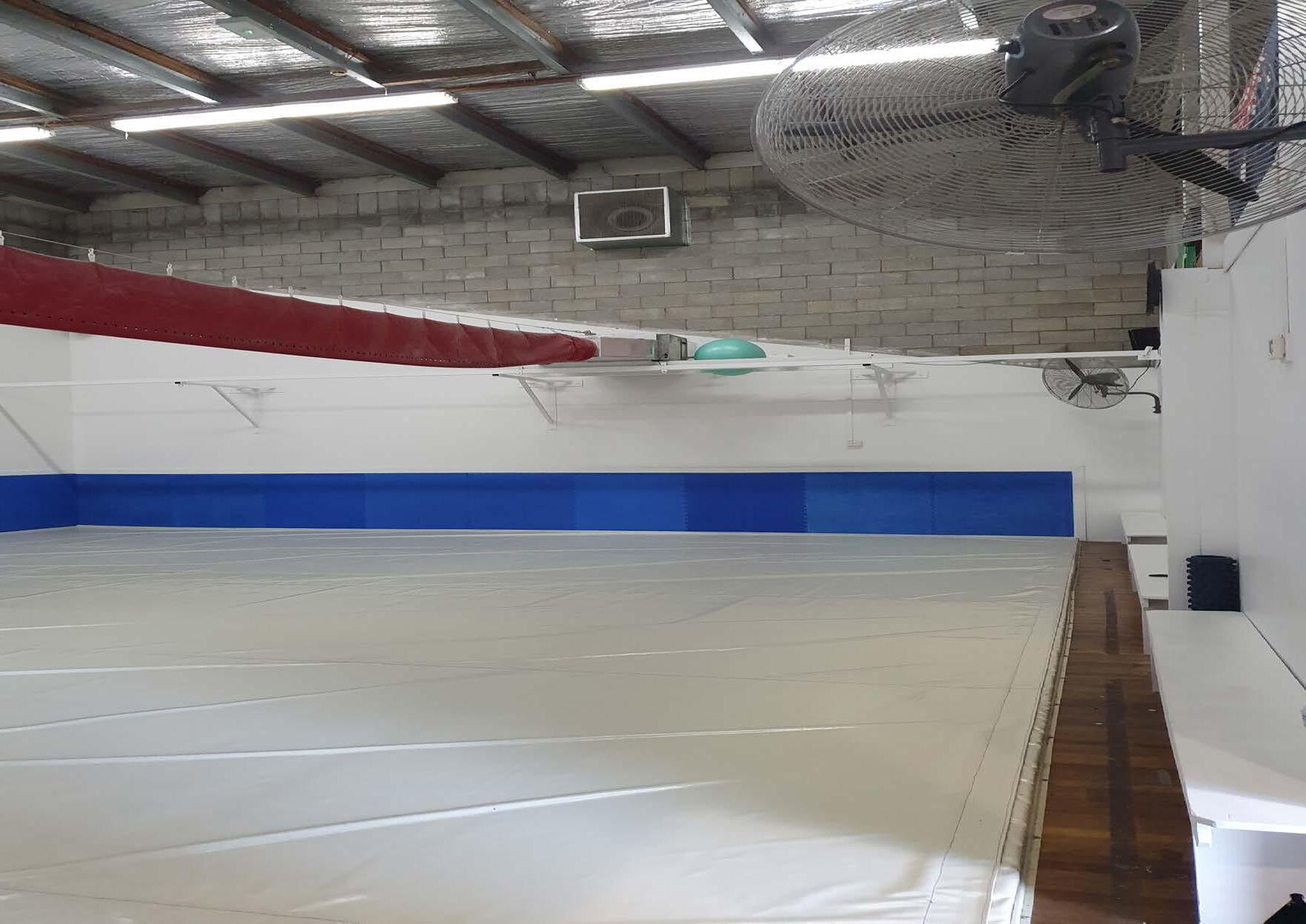
Netball is the highest female participation sport for both Tasmanians and Australians. Netball is ranked 8th in the top sports and physical activities participated in by Australian adults in 20221 and 7th for children.
Netball is ranked the 9th highest sport participated in by Tasmanians for children, and the 7th highest for adults in 20221. Netball reported the highest participation rate of any sport within the study area2
Participation in netball at a national level is steady for adults, whilst participation by children is decreasing. At a state level, netball is decreasing for children and fluctuating for adults. Eight local clubs provided membership data across the study area including one association, with participation data summed in the table below. This data includes state league participation. It is acknowledged that 2020 was a covid-19 affected year.
There are 19 outdoor netball hard courts across the study area. There are 3 local-level facilities including Beauty Point, Hadspen Recreation Ground and Campbell Town War Memorial Precinct. Two of these are multi-purpose courts.

There are two district-level netball facilities providing two courts each; the Deloraine Netball courts and George Town Sports Complex. The Northern Tasmanian Netball Centre at Hobblers Bridge Sports Centre is the regional centre for netball and provides 13 outdoor hard courts across two adjoining sites.
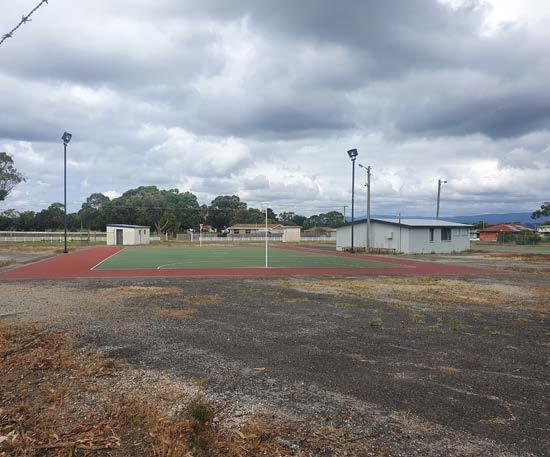
There are a small number of indoor venues catering for netball within the study area including the Longford Community Sports Centre (one court), Graham Fairless Centre in George Town (one court), the former YMCA in Launceston (two under-size courts), and the Silverdome (providing an additional three courts at times). A number of private schools are used by Tasmanian Netball League for training. A full list of facilities and their hierarchy by Local Government Area can be found within Appendix 2.
the Deloraine courts are relatively new and are in good condition. The courts are lit and the club has exclusive use of a small storage facility
the George Town courts are in poor condition, additionally the court surrounds including clubhouse require an upgrade for both functionality and amenity. Accessibility to the clubhouse is also an issue. The George Town club train indoors at the Graham Fairless Centre
North Esk Netball Club utilise the indoor facilities of two primary schools for training which are currently suitable. However, the club is growing and will struggle in future to provide sufficient venues based on suitable times for training. The club find it difficult to find indoor venues for training
the Northern Tasmania Netball Centre courts at Hobblers Bridge are in poor condition. They are unsafe and require resurfacing and expansion due to their lack of run-off. Netball courts on the Hart Street side have issues with the surrounding tree roots causing damage to the court surfaces. The courts are dangerous when wet due to the weeds and grass growing through the cracks in the courts 1 Ausplay 2022 2 Northern Tasmania Sports Facility Plan Community Survey 2022
clubs do not have access to the Northern Tasmania Netball Association building for club meetings or functions and have a desire for storage
gender appropriate change facilities are required at the Centre given the growth in male participation in the sport clubs have identified the need to install additional lighting over courts to facilitate the weekly training requirements of the 15 affiliated clubs (only 6 courts are currently lit) the courts are at capacity with too many clubs located there.
the Silverdome is used for senior competition. However, teams are displaced regularly in favour of other events and it is costly to book
Longford Netball Club train at the Longford Community Sports Centre indoor court and have identified a need for additional courts for training to accommodate their growing club.
The majority of clubs have identified the need for a designated indoor facility for games given the climate. Additionally, junior games are played in cold and wet conditions which impacts participation in the sport.
The study area does not meet the preferred provision ratio of 1 outdoor court per 5,000 residents. There are currently 19 courts compared to the required 27 in 2022. There is a predicted shortfall of 14 courts in line with population growth by 2036 (without additional court development). Albeit the shortfall of outdoor courts, given the shift of the sport from outdoor courts to indoor, the future provision of courts should be focussed on the provision of and access to suitable indoor facilities.
Netball Tasmania recognises the need for the development of an indoor, multi-court facility to cater for the current and future needs of the sport. The need for an indoor facility is for both the community and elite sectors of the sport. Additionally, state wide competitions and high performance programs are required to be played indoors.
The Northern Tasmania Netball Association (NTNA) have identified that growth in netball is limited due to the inability to fit additional teams/games into the roster. The NTNA are at capacity and are turning participants away. They introduce byes and reduce the length of quarters to fit in their roster.
Netball is predominately becoming an indoor sport, with over 70% of games played indoors. Additionally, with climate considerations, both cold and wet weather limits the use of outdoor courts, with no all-weather venue available to play regular games or host make-up fixtures.
there are 1,550 members who use the Northern Tasmanian Netball Centre on a weekly basis, this facility is over-capacity and in need of an upgrade
the cost of hiring the Silverdome is prohibitive, and games are displaced regularly for events (despite fixtures being booked 12 months in advance)
there is a lack of club rooms available for meetings at the Northern Tasmania Netball Centre
the Northern Suburbs Community Hub currently being planned for Mowbray will include four indoor courts dedicated to netball.
continue to pursue strategic investment opportunities including acquisitions, that deliver on the recommendations of the Plan, particularly those that build on and expand existing netball facilities
continue to advocate for the provision of four dedicated indoor netball courts as part of the Northern Suburbs Community Hub development
following the completion of the Northern Suburbs Community Hub and the provision of four dedicated indoor courts for netball, there is a need to undertake further analysis into the demand for additional indoor courts to cater for future demand
Netball Tasmania to work with the Silverdome to guarantee continued use of the venue for regular games
undertake court re-surfacing and expansion to meet run-off requirements at Northern Tasmania Netball Centre
develop a shared clubhouse facility at the Northern Tasmania Netball Centre to allow club access for meetings and functions
upgrade the George Town netball clubhouse and court surrounds in line with the George Town Sports Complex master plan
plan for the duplication of the Longford Community Sports Centre.
Westbury Indoor Sports Centre
Roller Skating participation
Meander Valley Performing Arts Centre
Participation in roller derby at a national level is steady for both adults and children. At a state level, roller derby is steady for children and increasing for adults. Two local clubs provided membership data.
Juniors
Existing facilities
Roller Derby operates out of indoor sports venues, with the Westbury Sports Centre being the key location used for training and home games within the study area. Private venues are also used including Skate and Sport at Mowbray. Elphin Indoor Sports Centre is used occasionally, however, gaining access to this facility is difficult.
The Cradle Coast Junior Rollers train at the Westbury Sports Centre, however travel to East Devonport Recreation Centre for competition.
Existing facility carrying capacity
The Westbury Sports Centre floor is in poor condition and requires an upgrade.
There is a distinct lack of indoor venues within the study area, particularly in close proximity to Launceston (where the Devil State Derby League is based). Clubs are seeking a suitable indoor training venue in close proximity to Launceston.
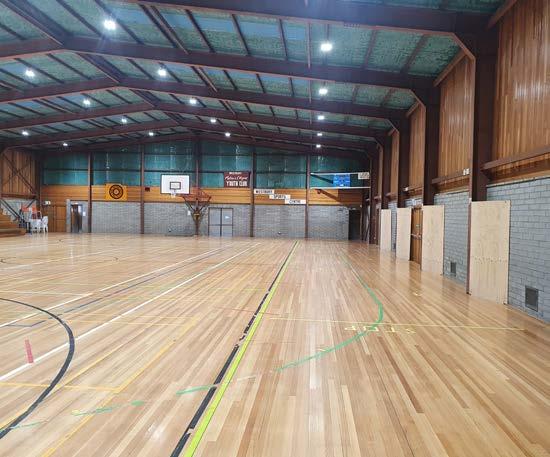
Considerations
clubs currently travel from Launceston to Westbury for training and have a desire for a Launceston training venue
the Westbury Sports Centre flooring needs an upgrade.
Recommendations
investigate the use of the former Launceston PCYC for training
upgrade the flooring of the Westbury Sports Centre.
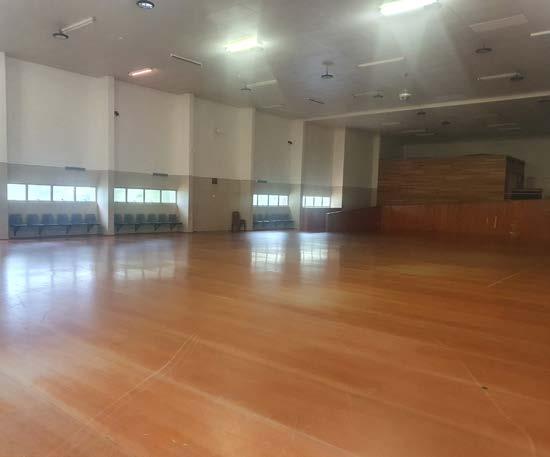
Rugby Union participation
Rugby Union is ranked the 15th highest sport participated in by Tasmanians for children and the 17th highest for adults in 20221. Participation in rugby union at a national level is steady for adults and increasing for children. At a state level, rugby union participation is very limited for children and steady for adults. No local clubs provided membership data.
Existing facilities
Royal Park is the home of Rugby Union providing the sole rugby Union field within the study area. The Launceston Rugby Union facility has one lit field and a clubhouse.

Existing facility carrying capacity
The study area does not meet the preferred provision ratio of 1 field per 62,500 residents. There is currently 1 field compared to the required 2 in 2022. There is a predicted shortfall of 2 fields in line with population growth by 2036 (if no additional fields are developed).
It is thought that while the sport does not meet the accepted provision ratios, the current provision of facilities in the study area appears to reflect membership numbers and subsequent demand for facilities.
Considerations
Australia is hosting the Rugby World Cup in 2027 and 2029 which may result in additional interest in the sport at a national level.
The study area is unlikely to host any training or matches, and subsequently any planned upgrades to the Royal Park facility should be focused on meeting local demand.
The clubhouse is in poor condition and in need of an upgrade to improve its condition and functionality.
Recommendations
support the plans for the upgrade of the Launceston Rugby Union change rooms
consider the need for a warm-up area at Royal Park adjoining the existing field, should the tennis courts be rationalised.
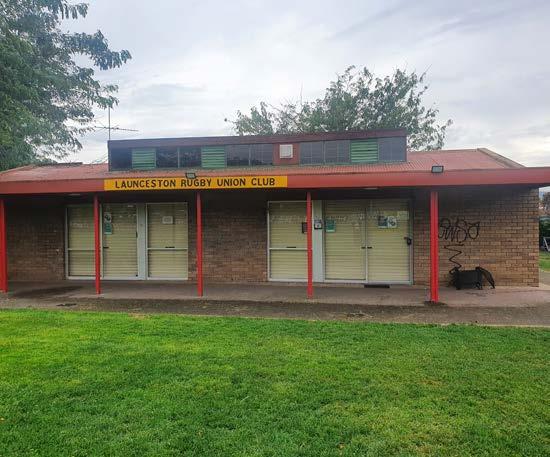
Sailing is ranked the 17th highest sport participated in by Tasmanians for children and the 9th highest for adults in 20221
At a state level, sailing is negligible for children, and steady for adults. Australian Sailing (Tasmania) has provided participation numbers for the five council areas:
Existing facilities
There are four sailing clubs within the study area; Port Dalrymple Yacht Club, Deviot Sailing Club, Tamar Yacht Club and George Town Yacht Club.
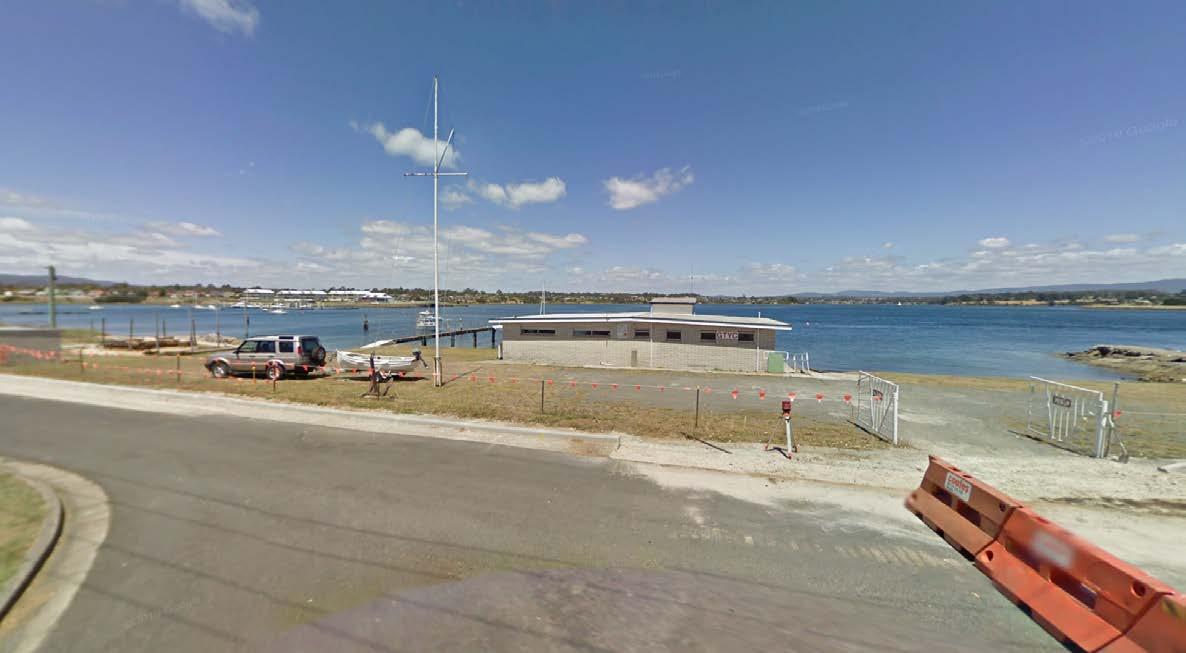
Existing facility carrying capacity
Club accessibility for all abilities is generally poor across the facilities. Most do not have a wheelchair friendly venue (including access to toilets, change rooms, ramps, pontoons, and/or jetties). These issues are restricting the ability for the clubs and sport to be truly inclusive.
The current provision of facilities in the study area appears to be in line with membership numbers and subsequent demand for facilities.
Australian Sailing (Tasmania) highlighted the ageing population coupled with the lack of volunteers/instructors to deliver training as the main barriers to participation in sailing.
Sailing clubs are generally welcoming of all water sports and activities. Increasing activity at each facility through encouraging complementary water sports such as canoeing and kayaking may assist in increasing club membership. To support this, there is a need for better storage facilities for small water craft.
Considerations
There is a need to be innovative in attracting new members and activity at the clubs within the study area.
Given the ageing population and the desire of clubs to be inclusive, there is a need for fully accessible facilities.
Recommendations
undertake an accessibility audit of the facilities and prioritise the implementation of improvements
determine the requirements of each club to cater for complementary water sports.
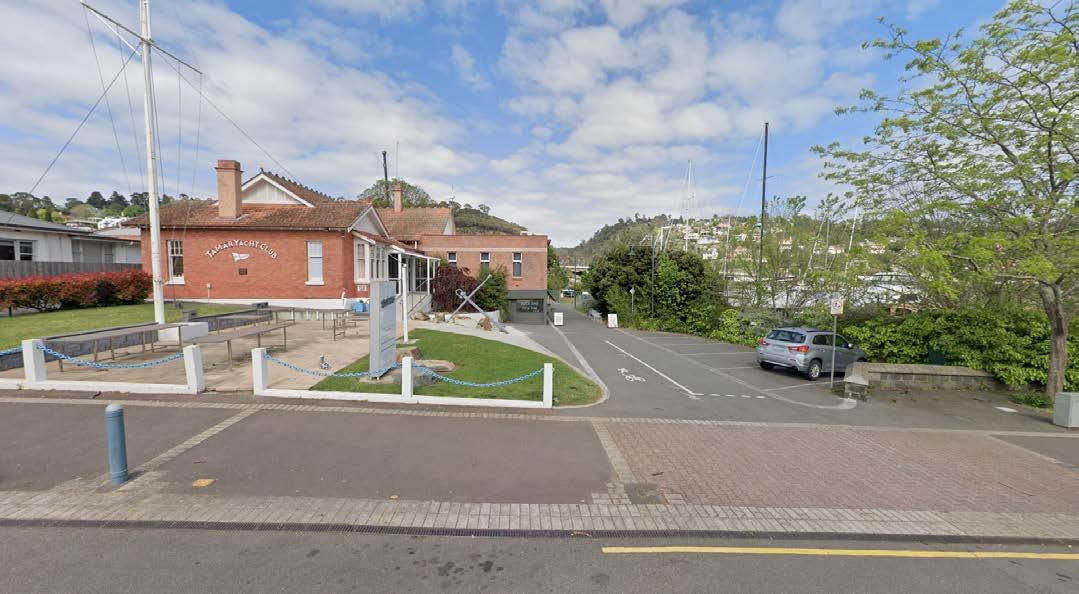
Softball is ranked the 13th highest sport participated in by Tasmanians for children and the 19th highest for adults in 20221
Participation in softball at a national level is steady for both adults and children. At a state level, softball participation is very limited for children and increasing for adults. Tasmania Softball have provided membership data for the Northern Tasmanian Softball Association:
Churchill Park in Invermay is the sole softball facility within the study area. The facility is shared with baseball, with two diamonds. Softball primarily use Diamond 1.


The study area is well provided for in regards to the provision of softball (and baseball) facilities. While the preferred provision ratio of 1 diamond per 50,000 residents is not being met, given the very low club membership, there is no evidence to suggest that the current provision is not meeting the requirements of the study area.
Participation in the sport is relatively low at a national, state and local level. If the club can demonstrate consistent growth in membership, a 3rd diamond catering for baseball and softball may be required by 2036.
Additional seating and shaded areas would enhance the facility.
Recommendations
work with baseball and softball to improve shared use of the facility
install shaded seating for spectators.
Squash is ranked the 15th highest sport participated in by Tasmanians for adults, and is not ranked for children given its limited participation in 20221
Participation in squash at a national level is steady for adults, however, is negligible for children. At a state level, squash participation is very limited for children and increasing for adults. Two local clubs have provided membership data.
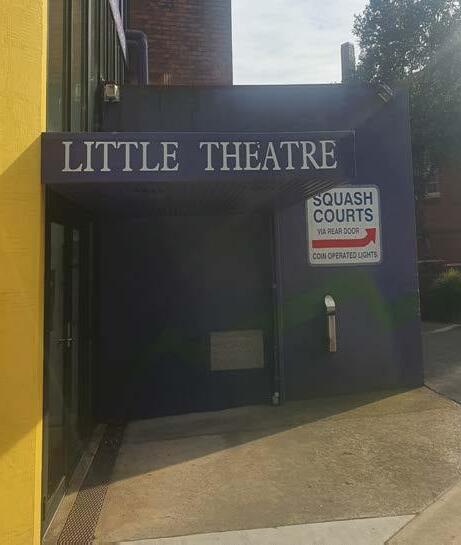
The study area has four known facilities that provide for squash; Meander Valley Performing Arts Centre, Westbury Indoor Sports Centre, Exeter Community Club and the Longford Community Sports Centre.
A dedicated squash facility is currently under construction in Deloraine.
At present, the existing facilities are unable to host State and inter-State tournaments.
A full list of facilities and their hierarchy by Local Government Area can be found within Appendix 2.
Existing facilities in Deloraine and Westbury are dated and do not meet current standards for the sport. These courts cannot be used for State and inter-State tournaments. The new facility being built in Deloraine will provide four new courts that are expected to be suitable to attract junior state development squads, senior state competitions and master competitions.

Considerations
Once the Deloraine facility has been built, the existing facilities in Deloraine and Westbury may become redundant.
consider re-purposing the existing courts at the Meander Valley Performing Arts Centre following the completion of the new facility in Deloraine
monitor the demand for the Westbury facility following the development of the new facility in Deloraine.
Swimming participation
Swimming is the 4th overall sport and physical activity participated in by adults in Australia and the 2nd highest organised sport and physical activity for children in 20221
Participation in swimming at a national level is increasing for both adults and children. At a state level, swimming is increasing for children and steady for adults. Swimming Tasmania have provided membership data for the Northern Clubs:
There are a number of swimming pools within the study area. The Cataract Gorge (First Basin) also provides informal swimming opportunities.
Local-level aquatic facilities include the Campbell Town Swimming Pool, Ross Swimming Pool, Cressy Swimming Pool, Deloraine Swimming Pool and Lilydale District Swimming Pool. The Riverside Aquatic Centre is a district-level facility.
There are two regional-level facilities - the George Town Swimming Pool and the Launceston Aquatic Centre. The George Town Swimming Pool has major upgrades planned to meet the needs of the George Town community. The existing outdoor 25m pool and water slide will be enhanced by the provision of an indoor 3 lane lap pool as well as an indoor therapy pool as well as gym and fitness centre.
Riverside Swim Centre pool is at the end of its useful life and is planned for upgrade in the near future in line with the West Tamar Aquatic Facility Strategy.

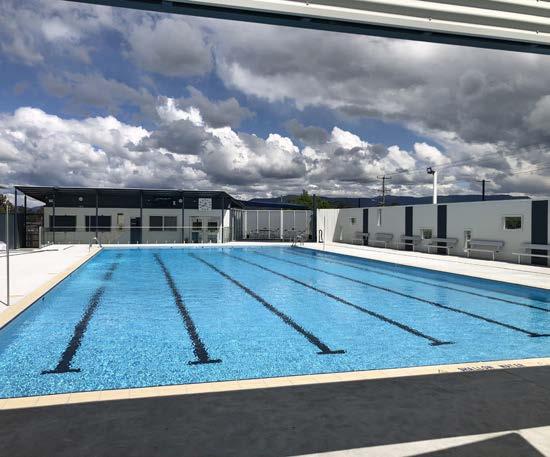
A full list of facilities and their hierarchy by Local Government Area can be found within Appendix 2.
The study area currently has an over-supply of facilities based on the preferred provision ratios of one 25m pool per 30,00050,000 residents. This does not take into consideration the access requirements of residents living in small towns and villages away from population centres . When applying the additional benchmark of one 50m pool per 100,000 residents, minor shortfalls exist to 2036 (however still an over-supply in 25m pools).
Swimming Tasmania have identified that they are a growing sport and feel they have a lack of pool availability for lane hire.
Swimming Tasmania has a desire for a new 10 lane facility with even depth to enable Swimming Tasmania to bring national swim meets to the area.
The planned upgrade of the George Town Swimming Pool will enhance the current provision of swimming facilities, and cater for the needs of the George Town community. Similarly, the Riverside Swim Centre upgrade will provide a modern aquatic and leisure facility.
The majority of the regions population has close access to the network of swimming pools and aquatic facilities.
Additionally, the minor deficiency in 50m pool by 2036 is more than catered for by the over-supply of 25m pools across the study area.
Peoples willingness to travel to access such facilities has been confirmed though the community survey, with some examples of respondents travelling up to 67km for swimming.
Whilst there may be some capacity issues for squad swimmers at the Launceston Aquatic Centre as identified by Swimming Tasmania, there needs to be a number of management and scheduling strategies implemented long before the development of a new facility to ensure the current facility’s utilisation is maximised.
A number of private and commercial swimming pools exist within close proximity to the Launceston Aquatic Centre including at schools. Use of these facilities should be maximised by clubs in conjunction with Council facilities to ensure no unnecessary facilities are developed.
Aquatic facilities require significant initial capital expenditure and ongoing maintenance costs.
with the exception of the planned upgrade to the George Town Swimming Pool and Riverside Swim Centre, no new aquatic facilities are recommended for the life of the Plan, to 2036
continue to promote access to a range of aquatic facilities across the study area
any approach by swimming Tasmania for a national standard facility in the Northern Tasmania region should include detailed discussion with Sport and Recreation Tasmania and relevant Councils to ensure the best location and facility scope is identified across the state
if demonstrated demand for an additional facility exists in 2036, undertake an investigation into the feasibility of expanding an existing facility, including its possible enclosure.
Table Tennis is ranked the 11th highest sport participated in by Tasmanians for children and the 17th highest for adults in 20221
Participation in table tennis at a national level is increasing for both adults and children. At a state level, table tennis is negligible for children, and increasing for adults. Table Tennis Tasmania has provided membership data for the study area:
The study are has two known facilities that provide for table tennis - Elphin Sports Centre and the Meander Valley Performing Arts Centre.
Northern Tasmania Table Tennis has a desire to host a State-level competition once each year. Their current facility at Elphin Sports Centre cannot accommodate this.


Northern Tasmania Table Tennis (based at Elphin Sports Centre) has a desire for a facility with capacity to hold 10 tables in order to host a State competition (annually). However, the current facility cannot cater for this.
The Deloraine Table Tennis League operate out of the Meander Valley Performing Arts Centre. They have a desire to remove benches along the wall to allow them to fit in one more court (making 9 in total). This would allow the club to run two extra social teams each week. It is noted that other hall users need the existing benches to undertake their activities.
Table tennis tables permanently set-up at Elphin Sports Centre take up valuable court space that could otherwise be booked for basketball (juniors or training), netball and other community sports with large membership bases.
The former YMCA facility in Launceston has the potential to accommodate table tennis as an alternate venue to Elphin Sports Centre.
relocate table tennis from Elphin Sports Centre with a view of having tables that can be packed up when not in use, to allow more equitable use of the space
initiate discussions with all users of the Meander Valley Performing Arts Centre to determine the need for fixed benches (and the possibility of the Table Tennis League fitting in an additional court).
Touch football is ranked 16th within the top 20 organised sport and physical activities participated in by adults and children in Australia in 20221
Participation in touch football at a national level is steady for both adults and children. At a state level, touch football is steady for children, and decreasing for adults. One local club provided membership data for the study area:
The study are has two known facilities that provide for touch football - Prospect Vale Park and the George Town Sports Complex.
The George Town Giants use the George Town Sports Complex for training and Prospect Vale Park for games. The club find the distance required to travel to Prospect Vale Park to play is a barrier.

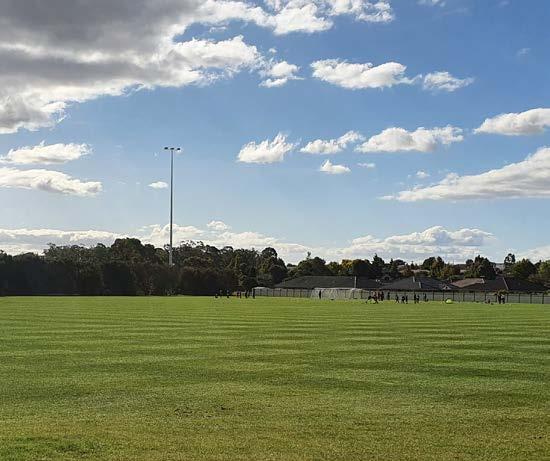
Across the study area, the provision of facilities for touch football appears to reflect demand for the sport.
George Town is geographically isolated from much if the study area and has a small population catchment. It would be difficult to run a successful touch football competition in this locality.
monitor demand for touch football facilities based on participation in the sport and population growth.
Tennis is ranked 10th in the top sports and physical activities participated in by Australian adults in 20221 and 8th for children.
Participation in tennis at a national level is increasing for adults and decreasing for children. At a state level, tennis is increasing for children and steady for adults. Six local clubs provided membership data for the study area, with combined membership totals displayed in the table below.
The study area is well provided for in tennis, with 63 tennis courts. Provision includes a wide range of facilities from unlocked, free-to-play shared courts to regional-level facilities with multiple courts.
the Hadspen Recreation Ground provides a multi-purpose court classified as active recreation.
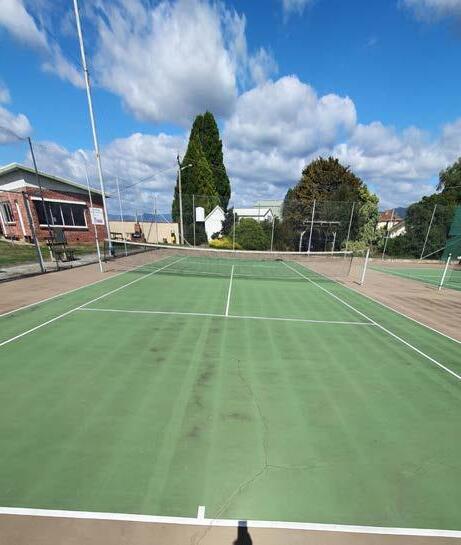
local-level facilities include Campbell Town War Memorial Oval Precinct, Perth Tennis Club, Evandale Tennis Club, Westbury Tennis Club, Whitemore Recreation Ground, Carrick Memorial Recreation Ground, Royal Park, Hillwood Oval, Weymouth Tennis Courts, Bellingham Sports Oval, Beechford Recreation Area, Beaconsfield Tennis Centre, Pipers Rivers Recreation Ground, Pipers Brook Tennis Courts (not in use), Karoola Recreation Ground and Myrtle Park Recreation Ground.

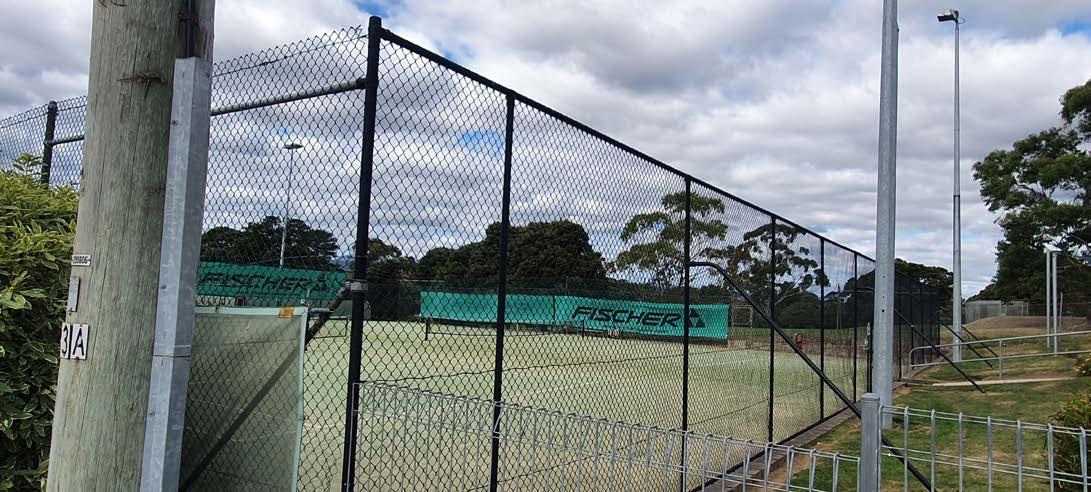
district-level facilities include Deloraine Tennis Courts, George Town Sports Complex (not in use) and Riverside Centre.
the study area has one regional-level facility - the Regional Tennis Centre (Tennis World) that provides 11 courts (2 clay courts and 9 hard courts).
A full list of facilities and their hierarchy by Local Government Area can be found within Appendix 2.
The study area currently has an over-supply of courts based on the preferred provision ratio of 1 court per 2,500 residents. There are currently 63 courts compared to the required 55 in 2022. Even considering the predicted population growth within the study area, there will still be an over-supply of 2 courts in 2036.
The Karoola Tennis court is in poor condition and has no evidence of current usage.
The Royal Park courts require re-surfacing and repairs to the fence. Use of the courts are unclear. Given the proximity to Tennis World and the good condition of these courts, consideration needs to be given to removal of these courts. This would allow the Rugby Union Club to expand their facilities, or provide a small warm up area.
Trevallyn Park has some tennis courts that are in dis-repair. The club is currently renewing two courts and improving lighting and fencing.
Bluegum Park in Launceston is an informal tennis facility in poor condition and poses a significant safety risk considering its location and complete lack of surveillance.

The George Town tennis courts are in poor condition and require resurfacing. The George Town Sports Complex Master Plan recommends the combination of netball and tennis courts in an upgraded facility. The netball courts are in good condition. The tennis courts are currently not in use and it is recommended that the facilities remain separate for the benefit of both sports.
Beaconsfield Tennis Club has identified the need to undertake a surface clean of their hard court to improve safety and lighting to increase hours of use. Their fence is also in need of replacement. Additionally, improved all abilities access to courts and the clubroom via a wider gate and a ramp is required
Longford Tennis Club has noted the need for repairing surface cracks and court resurfacing to ensure the safety of the courts. The club has a desire for improved lighting, with the existing lights ageing and providing varying levels across the courts. Additionally, the club have requested a hitting wall to enhance training facilities
Perth Tennis Club has identified the need for the development of a club room, toilet facilities and shaded area for players. The court surfaces are in poor condition and in need of re-surfacing
Riverside Tennis Club has identified that 2 of their 4 courts need replacing. The club has a desire for an additional two courts but expanding is difficult as the facility is land locked. The club feel their growth is restricted by the size of their facility. The Club reports being near to capacity and unable to grow without additional courts
Tennis Australia (Tennis World Launceston) has identified the need to upgrade their clubhouse including bathrooms and storage. The lighting is at the end of its useful life and courts require resurfacing
Whitemore Tennis Club has highlighted a number of concerns with their facility, including cracks in the courts and a lack of shade and seating.
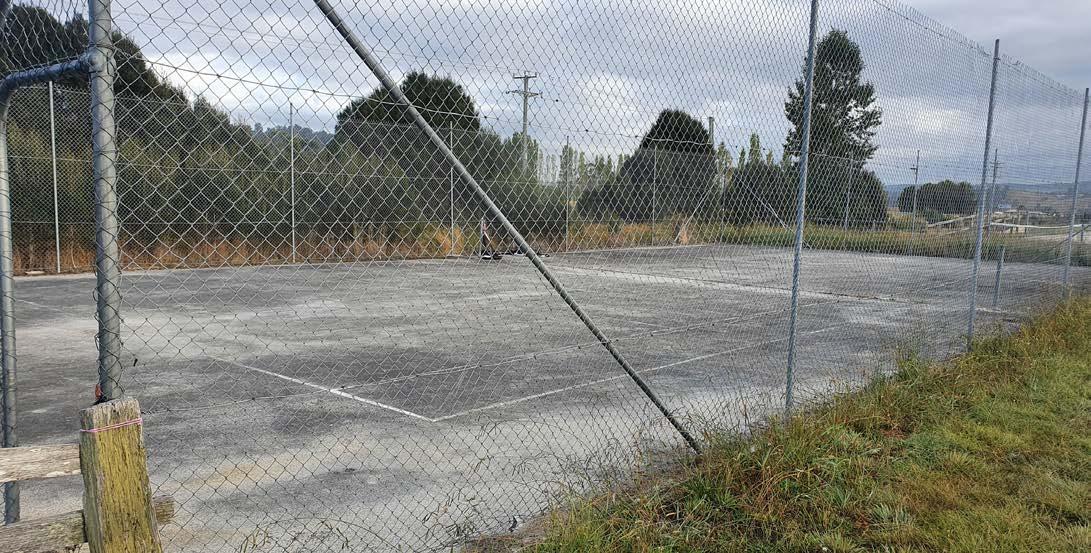
There is an over-supply of courts within the study area.
A number of courts are ageing and in poor condition, with little evidence of use.
A number of clubs have identified the need for major court improvements, clubhouse development or upgrade and lighting. There needs to be a holistic planning process to understand the demand for these items as well as prioritisation.
Recommendations
undertake a tennis network plan to identify the needs of each club in line with participation, and prioritise actions across the study area to ensure a fair and equitable approach
master plan the greater Trevallyn Park site and review management structure
rationalise the Karoola Tennis court due to its poor condition and lack of use
rationalise the Royal Park tennis courts given their poor condition and close proximity to Tennis World
Divest Bluegum Park court (City of Launceston) and discourage future use for community safety. This venue is a passive recreation/bushland area and should continue to provide this function only
undertake an accessibility audit of the Beaconsfield Tennis clubhouse and make recommendations for improvement.
To assist the working group and subsequently each council to prioritise the recommendations for their annual capital works budgets, a set of criteria have been developed. This criteria will allow the project working group to standardised the process for prioritising its open space capital works, while being transparent and equitable in its decision making. Each project is scored out of 100, with some factors having higher weight than others.
Factor
Planning Planning tool
Growth areas
Description
Priority should be given to projects that have been identified through the Northern Tasmania Sports Facility Plan 2023 and demonstrate strategic importance at either a local, district or regional level
Score
/10
Priority focus should be on supporting facilities within growth areas. This helps to ensure that there are facilities in growth areas that support the community at a local level /5
Club management For sportsgrounds and courts, priority should go to facilities that are managed in an efficient and effective way. As most facilities are leased/licenced, a condition of the lease/licence agreement should be that clubs have a management plan that incorporates asset management, financial management, club development and capital works planning
/5
Asset Management
Sub total /20
Asset condition
Priority should go towards projects that are improving an asset. Capital works should not be used to repair facilities, which should be undertaken through a maintenance program associated with the facility (either lessee or Council) or be indicated in an asset renewal schedule
/5
Function
Safety
While capital works should not be primarily used for funding safety aspects, safety and risk remain critical issues for Council /5
Sub total /10
Capacity
Access
Priority should be given to projects that will cater for increased participation in recreation, physical activity or sport /10
Priority should be given to facilities that cater for more than one sport or activity. Any leases/licenced facilities that have only one user group or club should be encouraged to share facilities if possible. Priority should also be given to community access as well as the clubs
/10
Function
Priority should be given to projects where there is a demonstrated need within the community. Funding should also target projects that are appropriate for the type of open space. There is a strong need for a variety of facilities to serve all areas of the community. A project at one site should not impact on the ongoing use of another facility and preference away from projects where needs are already being met elsewhere within its catchment
/10
Social impact
Priority should go to those projects that are targeting growth or emerging recreation activities and/or sports. Clubs or activities with limited or declining participation will need to look at the reasons why and address these issues to achieve a higher priority
/10
Sub total /40
Implementation of the recommendations outlined in this Plan will require strong leadership, appropriate resources from NTDC, councils and other funding partners, as well as a commitment to making some difficult decisions.
While this Plan presents a key guiding vision for the NTDC and councils (and the community), the overlaying issue will be the capacity to fund it. Exact individual project timing will be dependant on the availability of necessary funding (be it from local clubs, council, State or Federal Governments).
Priorities are assigned for each action. A high recommendation should be undertaken as soon as resources allow while medium (in the next 5-10 years) and low priorities (in the next 10-15 years) are not as urgent. Indicative costs are provided for the total project cost (not necessarily an individual council’s financial burden). More detailed costing should be undertaken for each project as its nears commencement.
Table 23:
Strategic priorities
1.1 The current working group has proven successful and should be maintained in order to oversee the management and monitoring of the Sports Facility Plan and its implementation
1.2 Continue to pursue strategic investment opportunities including acquisitions that deliver on the recommendations of the Plan, particularly those that build on and expand existing sport and active recreation facilities
1.3 Pursue partnerships with schools and education providers for joint use of sports facilities
1.4 Considering the high participation rates, undertake a demand study for informal active sport to better understand the communities need
1.5 Seek to promote the use of existing sport and active recreation facilities across the region through marketing and awareness and programming with a focus on social, unstructured and emerging activities
Ref
2.1 Continue to pursue strategic investment opportunities including acquisitions, that deliver on the recommendations of the Plan, particularly those that build on and expand existing AFL facilities
2.2 Develop training areas to support existing one-oval facilities where possible, including Bridgenorth Recreation Ground, Rocherlea Recreation Ground and Longford Recreation Ground
2.3 Deloraine Recreation Ground - redevelopment at the showground/race track could provide opportunity for a multi-oval facility
2.4 Exeter Showgrounds (private) - currently has 2 ovals catering for cricket and Mini League/Auskick. This facility could be formalised in partnership with council to provide for AFL
2.5 Investigate the development of at least two new multi-oval facilities in key locations close to population centres i.e. the Legana Structure Plan Growth Area and the growth area in the vicinity of St Leonards
2.6 Lilydale Recreation Ground requires an upgrade to the entrance road and installation of spectator shade
2.7 City of Launceston to complete the master planning process for the NTCA precinct with the NTCA Facilities Management Group
2.8 Implement the Perth Recreation Precinct Master Plan
3.1 Investigate inclusion of Little Athletics training facilities at the George Town Sports Complex re-development
3.2 Undertake a master plan of the St Leonards Sports Complex to determine the future needs of all users (athletics, hockey, BMX and croquet), including potential upgrade of the building, toilets and in-field area
3.3 In line with the outcomes of the master planning process, prioritise the facility upgrades at the Northern Athletics Centre
3.4 Promote the availability of the centre of St Leonards track for use by winter sport to train
3.5 Monitor the demand for additional athletics facilities based on the growth of the sport (and population growth)
4.1 Assess the suitability of the Deloraine Community Complex to continue to provide for badminton
5.1 Work with Baseball and Softball to improve shared use of the facility
Install shaded seating for spectators
6.1 Support the progression of the Northern Suburbs Community Recreation Hub concept plans in providing indoor courts
6.2 Continue to pursue strategic investment opportunities including acquisitions, that deliver on the recommendations of the Plan, particularly those that build on and expand existing indoor facilities
6.3 Identify a suitable location for the development of a future multi-court indoor facility to meet the growing needs of basketball
6.4 Plan for the duplication of the Longford Community Sports Centre
7.1 Undertake a master plan the St Leonard Sports precinct including BMX, hockey, athletics and croquet to determine the future needs of the facilities, including potential upgrade of the building, toilets and in-field area
7.2 Consider ancillary facility upgrades for the Launceston BMX Club including the provision of spectator viewing and improved lighting
7.3 Monitor the demand for additional BMX facilities in line with population growth
7.4 Consider the development of pump tracks within the Northern Midlands and City of Launceston to enhance the provision of active recreation across the study area
8.1 Continue to pursue strategic investment opportunities including acquisitions, that deliver on the recommendations of the Plan, particularly those that build on and expand existing cricket facilities
8.2 Develop multiple-oval facilities to enhance capacity and reduce pressure on playing surfaces - potential for Deloraine Recreation Ground (Racecourse)
8.3 City of Launceston to complete the master planning of the NTCA precinct with the NTCA Facilities Management Group
8.4 Formalise the use of Dover Reserve, Newstead Reserve and Charlton Reserve for training to take the pressure off other venues
8.5 Confirm the use of Lebrina Recreation Ground, Karoola Recreation Ground and Bellingham Sports Oval for cricket
8.6 Upgrade the clubroom and change facilities at Ross Recreation Ground to cater for its increased use
8.7 Undertake a Master Plan and Facility Management Review of Trevallyn Park (cricket, tennis and lawn bowls) including car parking and circulation
9.1 The East Launceston Croquet Club and City of Launceston to work together in undertaking an accessibility audit and developing a preferred site layout for the future of the facility, which includes the needs of the East Launceston Bowling Club
9.2 Investigate the feasibility of converting the disused tennis courts at East Launceston Croquet Club to a shared facility between croquet and bowls
9.3 As part of the master planning process of the St Leonards Sports Complex (athletics, hockey, BMX and croquet), include the Northern Tasmania Croquet Centre and work with clubs to implement facility sharing
10.1 Continue to monitor demand for off-road cycling and additional facilities across the study area in line with population growth and demand for the sport
10.2 Program the replacement of the George Town fence and spectator shelters, as well as improvements to the track surface
Equestrian
11.1 Investigate the demand for cricket at the Lebrina and Karoola Recreation Grounds. If there is no demand for cricket, there is the potential for equestrian uses to expand
11.2 Investigate the potential for Edinburgh Park to be expanded to include an expanded outdoor arena and covered yards
11.3 Equestrian Tasmania in conjunction with the clubs located within Northern Tasmania, undertake a strategic review of their facilities in the north
11.4 Support the Longford Racecourse Master Plan’s proposed equestrian precinct development
Football (soccer)
12.1 Continue to pursue strategic investment opportunities including acquisitions, that deliver on the recommendations of the Plan, particularly those that build on and expand existing football facilities
12.2 Investigate suitable land for the development of a new multi-field facility for football within the study area. There is potential for this facility to be located within the growth area near to St Leonards or Legana. The development of a synthetic pitch should be considered at this location
12.3 City of Launceston to complete the master planning process of the NTCA precinct with the NTCA Facilities Management Group
12.4 Master plan the greater NTCA/Elphin Indoor Sports/Tennis World precinct to improve car parking, access, circulation, rationalise some uses and provide opportunities to expand uses where practical
12.5 Upgrade the West Launceston Community Park to provide an additional training facility for Football. Lighting and field upgrade would be required in the first instance, with future upgrades to the existing public toilets
12.6 Encourage the use of Carrick Recreation Ground as a training venue for soccer and other sports
12.7 Investigate the need for a football field within the north of the Northern Midlands LGA
Gymnastics
13.1 Support the progression of the Northern Suburbs Community Recreation Hub concept plans in potentially providing shared use of an indoor facility
13.2 Monitor demand for gymnastics within the study area and support clubs in seeking access to existing indoor venues where appropriate
Hockey
14.1 Undertake a master plan of the St Leonards Sports Complex including hockey, athletics, BMX and croquet to determine the future needs of all facilities
14.2
In line with the outcomes of the master planning process, prioritise the facility upgrades at the northern Hockey Centre
14.3 Monitor demand in line with future participation patterns and population growth
15.1 Undertake a Lawn Bowls rationalisation strategy across the study area (particularly focussing on the City of Launceston) to determine the viability of the existing clubs and determine a future program of upgrades, consolidation and potential divestment
Master Plan the greater Trevallyn Park site
16.1 Support existing and emerging clubs in finding suitable venues within the study area
17.1 Continue to pursue strategic investment opportunities including acquisitions, that deliver on the recommendations of the Plan, particularly those that build on and expand existing netball facilities
17.2 Continue to advocate for the provision of four dedicated indoor netball courts as part of the Northern Suburbs Community Hub development
Following the completion of the Northern Suburbs Community Hub and the provision of four dedicated indoor courts for netball, there is a need to undertake further analysis into the demand for additional indoor courts
Netball Tasmania to work with the Silverdome to guarantee continued use of the venue for regular games
Undertake court re-surfacing and expansion to meet run-off requirements at Northern Tasmania Netball Centre
Develop a shared clubhouse facility at the Northern Tasmania Netball Centre to allow club access for meetings and functions
Upgrade the George Town netball clubhouse (in conjunction with tennis) and court surrounds
for the duplication of the Longford Community Sports Centre
the use of the former Launceston PCYC for training
the flooring of the Westbury Sports Centre
the plans for the upgrade of the Launceston Rugby Union change rooms
the need for a warm-up area at Royal Park adjoining the existing field, should the tennis courts be rationalised
an accessibility audit of the facilities and prioritise the implementation of improvements
the requirements of each club to cater for complementary water sports
softball
improve shared use of the facility
Consider re-purposing the existing squash courts at the Meander Valley Performing Arts Centre following the completion of the new facility in Deloraine
the demand for the Westbury facility following the development of the new facility in Deloraine
to promote access to a range of aquatic facilities across the study area
23.2 Any approach by swimming Tasmania for a national standard facility in the Northern Tasmania region should include detailed discussion with Sport and Recreation Tasmania and relevant Councils to ensure the best location and facility scope is identified across the state
23.3 If demonstrated demand for an additional facility exists in 2036, undertake an investigation into the feasibility of expanding an existing facility, including its possible enclosure
24.1 Initiate discussions with all users of the Meander Valley Performing Arts Centre to determine the need for fixed benches and the possibility of the Table Tennis League to fin in their additional court
25.1 Monitor the demand for touch football facilities based on the demand for the sport and population growth
26.1 Undertake a tennis network plan to identify the needs of each club in line with participation, and prioritise actions across the study area to ensure a fair and equitable approach
Master Plan the greater Trevallyn Park site and review management structure
Rationalise the Karoola Tennis court due to its poor condition and lack of use
Rationalise the Royal Park tennis courts given their poor condition and close proximity to Tennis World
Divest Bluegum Park court (CoL) and discourage future use for community safety
Undertake an accessibility audit of the Beaconsfield Tennis clubhouse and make recommendations for improvement
The following pages present desired facility provision standards for the key sports at two levels - district and regional. Councils will continue to be a key driver in the development of district-level facilities (largely through developer contributions and grants) and will strive to develop facilities according to the district-level provision standards. However, the development of regional-level facilities will require a collaborative approach where facilities may need to be staged in order to ultimately meet the regional-level provision standards. User groups and state (and national) sporting organisations will be expected to contribute to the development of these high-level facilities.
Facility component District Regional
Playing field (includes 5m runoff)
AFL - Preferred 175m x 145m, Minimum 145m x 120m
Cricket - Preferred 60m radius, Minimum 50m radius
Orientation North-south
Drainage (outside fencing) Basic
Irrigation Automated system
Sight screens n/a
AFL - Minimum 175m x 140m
Cricket - Preferred 70m radius, minimum 65m radius
North-south
Comprehensive system
Automated system
One at each end of the main field
Number of ovals Minimum 2 Minimum 1, 2 recommended and 3 desirable
Facility component District Regional
Pavilion see Appendix 2
Ball protection fencing Required if goals are within 10m of car parking, roads, buildings or footpaths
Car parking Off-street minimum 57 cars per oval
Cricket practice nets 2 synthetic practice nets per oval
Cricket wicket - turf 22.56m x 3.05m (5-6 pitches). Turf wickets require club contribution and require junior use
Cricket wicketsynthetic 28m x 2.8m
Drinking fountains 2 per oval
Off-street minimum 57 cars per oval
Minimum 2 synthetic practice nets per oval (consideration of turf practice nets as an alternative or additional option)
22.56m x 3.05m (8-10 pitches). Turf wickets require club contribution
Fencing Vehicle and pedestrian fencing around the facility Vehicle and pedestrian fencing around the facility
Goal posts Goals posts - 10m out of ground
Point posts - 6.5m out of ground
Oval fencing Post and rail fencing around each oval
Park furniture
Player shelter
6 bench seats per oval
Goals posts - 12m out of ground
Point posts - 8m out of ground
Cyclone wire mesh infill
2 fixed shelters on western side of oval (8 seat capacity)
Playspace Local-level play node
Public toilets
Rubbish bins
Externally accessible at the pavilion
Minimum 1200 litres per oval
Scoreboard Scoreboard stand provided. Minimum 2m high and 2.6m wide
Shade Consider spectator shade in key gathering areas
Sportsfield lighting Ovals lit to training standard with capacity to expand the main oval to competition standard
Local-level play node
Externally accessible at the pavilion
2400 litres for main oval, 960 litres for secondary ovals
Elevated manual scoreboard with scorer’s room. Storage below
Competition standard lighting on at least one oval, other ovals lit to training standard with capacity to expand to competition standard
1 Desired standards are based on AFL Preferred Facility Guidelines, August 2012. Council’s ‘district’ facility is ‘local’ in the AFL Guidelines. Council’s ‘regional’ facility is ‘regional’ in the AFL guidelines
2 Desired standards are based on Cricket Australia’s (CA) Community Cricket Facility Guidelines, September 2015. Council’s ‘district’ is ‘club (home)’ in the CA Guidelines. Council’s ‘regional’ is ‘Premier/Regional’ in the CA guidelines.
Facility component District Regional
Orientation North-south
Track surface Permanent synthetic track of 400m circumference with minimum 8 lanes, and 10 front straight lanes for 110m hurdles events. (Construction in accordance with guidelines as outlined in IAAF Track and Field Facilities Manual)
Steeplechase
Combined discus/ hammer cage
Permanent water jump (inside or outside the track)
Minimum of 1 permanent combined throwing cage
Shot put circle Minimum of 2 permanent throwing circles
Javelin Minimum of 1 synthetic approach
High jump Minimum of 1 synthetic ‘D’
Long/triple jump 2 double-ended synthetic approaches with pits
Pole vault Minimum of 1 synthetic approach (across ‘D’ with vaulting box)
Irrigation Automated system
Associated infrastructure considerations
Permanent synthetic track of 400m circumference with minimum 8 lanes, and 10 lanes in front and back straights for 110m hurdles events. (Construction in accordance with guidelines as outlined in IAAF Track and Field Facilities Manual)
Permanent water jump (inside or outside the track)
2 permanent combined throwing cages
Up to 3 permanent throwing circles
2 synthetic approaches
2 synthetic ‘Ds’
Up to 4 double-ended synthetic approaches with pits
2 synthetic approaches with vaulting box (across ‘D’ and in one of the straights)
Facility component District Regional Pavilion see Appendix 2
Car parking Assessment require for the site Assessment required for the site Drinking fountain Minimum of 2 Minimum of 4
Fencing Vehicle and pedestrian fencing around the facility
Park furniture 6 bench seats
Playspace Local-level play node
Public toilets Externally accessible at the pavilion
Rubbish bins Minimum 1200 litres
Shade Consider spectator shade in key gathering areas
Vehicle and pedestrian fencing around the facility
Minimum of 8 bench seats
Local- to district-level play node
At the pavilion (and potential for additional standalone)
Minimum 2400 litres
Sportsfield lighting Lighting to recreation and training standard Lighting to club competition
Storage shed 75m2 (minimum)
1 Based on IAAF Track and Field Facilities Manual 2008 guidelines
(minimum)
Facility component District
Regional
Size Baseball - 98m along foul lines and 114m to centre outfield from home plate
Softball - 83.82m radius from home plate
Backnet Permanent backnet for 2 diamonds (minimum) Permanent backnet for 2 diamonds (minimum) with at least one having fencing extensions between home plate and first base and home plate and third base
Outfield fencing Full outfield fencing (portable) Full outfield fencing (portable or permanent)
Number of fields Minimum of two full-size diamonds with no outfield overlaps
Infield Grass with skinned running tracks
Grass (or skinned) with skinned running tracks
Outfield Grass surface with automated irrigation and quality drainage
Facility component District
Pavilion see Appendix 2
Car parking Off street minimum 36 cars per diamond
Drinking fountain 1 per diamond
Regional
Fencing Vehicle and pedestrian fencing around the facility Vehicle and pedestrian fencing around the facility Park furniture 4 bench seats per diamond
Player dugouts Permanent dug outs for 2 fields minimum (located along run to first base and run to home plate)
Playspace Local-level play node
Public toilets Externally accessible at the pavilion
Rubbish bins 720 litres per oval
Scoreboard Scoreboard stand provided. Minimum 2m high and 2.6m wide
Shade Consider spectator shade in key gathering areas between diamonds
Sportsfield lighting Diamonds lit to training standard with capacity to expand the main diamond to competition standard
Competition standard lighting on at least one diamond, other diamonds lit to training standard with capacity to expand to competition standard
1 Desired standards are based on Baseball Victoria Regulations for New Baseball Fields (October 2014)
Size Playing surface 28m x 15m with at least a 2m run-off from the court to any obstructions
Surface Hard, flat surface, usually timber
Surface Majority turf, consider demand for synthetic
Associated infrastructure considerations
Pavilion see Appendix 2
Ball protection fencing
Required if goals are within 10m of car parking, roads, buildings or footpaths
Car parking Off street minimum 40 cars per field
Drinking fountain 1 per field
Preference for 200 car parks within 400m of the ground (minimum 40 cars per field)
Fencing Vehicle and pedestrian fencing around the facility (spectator fencing around each field)
Goals Permanent and semi permanent goals must conform to Australian Standard AS 4866.1-2007 - Playing field equipment- Soccer goals Part 1: Safety aspects and be properly installed and secured. Moveable goals must be complaint with the Australian Competition and Consumer Commissions Consumer Protection notice no28. of 2010
Park furniture 4 bench seats per field
Pitch fencing Post and rail preferred
Player shelters
2 shelters on western side of field (5-seat capacity)
Playspace Local-level play node
Public toilets Externally accessible at the pavilion
Rubbish bins 720 litres per field
Scoreboard Scoreboard stand provided. Minimum 2m high and 2.6m wide
Shade Consider spectator shade in key gathering areas
Sportsfield lighting
At least two fields lit to training standard with capacity to expand the main field to competition standard
Post and rail with chain mesh infill
2 shelters on western side of field (8-seat capacity)
1440 litres for main field and 720 litres for additional fields
Elevated manual scoreboard on main field
Competition standard lighting on at least one field, other fields lit to training standard with capacity to expand to competition standard
1 Desired standards are based on Football Federation Victoria (FFV) 2014 Rules of Competition. Council’s ‘District’ is ‘Class D’ in the FFV Guidelines. Council’s ‘Regional’ is ‘Class B’ in the FFV guidelines.
Facility component District Regional
Size Hockey - 101.44m x 63m (inclusive of run-offs)
Lacrosse - 108.58m x 62.86m (inclusive of run-offs)
Orientation North-south
Field surface Synthetic turf
Number of fields Minimum one pitch with capacity to expand to two Minimum two pitches
Facility component District Regional
Pavilion see Appendix 2
Ball protection fencing
Required if goals are within 10m of car parking, roads, buildings or footpaths
Car parking Off street minimum 30 cars per pitch
Drinking fountain 1 per pitch
Fencing Vehicle and pedestrian fencing around the facility
Park furniture 4 bench seats per pitch
Player shelters 2 shelters per pitch (6-seat capacity)
Playspace Local-level play node
Public toilets Externally accessible at the pavilion
Rubbish bins 720 litres per oval
Scoreboard Scoreboard stand provided. Minimum 2m high and 2.6m wide
Shade Consider spectator shade in key gathering areas
Sportsfield lighting At least one pitch lit to training standard with capacity to expand the main pitch to competition standard
Competition standard lighting on at least one pitch, other pitches lit to training standard with capacity to expand to competition standard
1 Desired standards are based on Hockey South Australia Statewide Facilities Strategy. Council’s ‘District’ is ‘Level E’ in the HSA Guidelines. Council’s ‘Regional’ is ‘Level C’ in the HSA guidelines
Facility component District Regional
Size Playing surface 37-40m x 37-40m
Surface Grass and/or synthetic turf
No. of greens Minimum 2 with capacity for a third
Drainage Comprehensive system
Associated infrastructure considerations
Three or more
Facility component District Regional
Pavilion see Appendix 2
Car parking Off street minimum 34 cars per green
Drinking fountain 1 per green
Fencing Vehicle and pedestrian fencing around the facility
Park furniture 12 bench seats per green
Player shelters Permanent shade structures (minimum 1 per 3 rinks)
Public toilets Externally accessible at the pavilion
Rubbish bins 480 litres per green
Scoring stands 1 for each rink on each green
Shade Consider spectator shade in key gathering areas
Sportsfield lighting Training standard on at least one green
Competition standard on at least one green, consider demand for training standard on others
Facility component District Regional
Size 30.5m x 15.25m (run-off 3.05m outside sidelines and/or 3.65m between courts)
Orientation North-south
Court surface Hardcourt (asphalt, concrete or plexipave)
Hardcourt (plexipave preferred)
Number of courts Minimum 1 court with capacity to expand to at least 2 Minimum 6 courts
Associated infrastructure considerations
Facility component District Regional
Pavilion see Appendix 2
Car parking Off street minimum 30 cars per court
Drinking fountain 1 per court
Off street minimum 30 cars per court (with overflow areas)
Fencing Vehicle and pedestrian fencing around the facility (no fencing near court area)
Park furniture 2 bench seats per court (not in run-off areas)
Player shelters 2 shelters per court (not in run-off areas)
Playspace Local-level play node
Public toilets Externally accessible at the pavilion
Rubbish bins 240 litres per court
Opportunities for shelters dependent on court design
Scoreboard Scoreboard stand provided. Minimum 2m high and 2.6m wide
Shade Consider spectator shade in key gathering areas
Sportsfield lighting At least one court lit to training standard with capacity to expand the main court to competition standard
Competition standard lighting on at least one court, other courts lit to training standard with capacity to expand to competition standard
1 Desired standards are based on SRV Netball Court Planning Guide
Size (playing area and runoff)
Rugby league - Minimum 122m x 78m. Maximum 132m x 78m
Rugby union - Minimum 120m x 78m. Maximum 144m x 80m
Gridiron - 120m x 58.8m
Orientation North-south
Drainage Basic Comprehensive system
Irrigation Automated system
Number of fields 2 fields
Pavilion see Appendix 2
Ball protection fencing
2 fields
Required if goals are within 10m of car parking, roads, buildings or footpaths
Car parking Off street minimum 50 cars per field
Drinking fountain 1 per field
Off street minimum 50 cars per field (with overflow areas)
Fencing Vehicle and pedestrian fencing around the facility (spectator fencing around each field)
Park furniture 4 bench seats per field
Player shelters 2 shelters on western side of field (4-seat capacity)
Playspace Local-level play node
Public toilets Externally accessible at the pavilion
Rubbish bins 720 litres per field
2 shelters on western side of field (6-seat capacity)
Scoreboard Scoreboard stand provided. Minimum 2m high and 2.6m wide
Shade Consider spectator shade in key gathering areas
Sportsfield lighting Fields lit to training standard with capacity to expand the main field to competition standard
Competition standard lighting on at least one field, other fields lit to training standard with capacity to expand to competition standard
1 Desired standards are based on NRL Preferred Facility Guideline (2014). Council’s ‘District’ is ‘Local’ in the NRL Guidelines. Council’s ‘Regional’ is ‘Regional’ in the NRL Guidelines
2 Desired standards are based on Australian Rugby Union National Community Rugby Facilities Strategy (2012). Council’s ‘District’ is ‘Local’ in the ARU Guidelines. Council’s ‘Regional’ is ‘State/Regional’ in the ARU Guidelines. World Rugby Laws of the Game were referenced for ground dimensions
Orientation North-south
Court surface Synthetic grass or hardcourt (plexipave)
Facility component District
Pavilion see Appendix 2
Car parking Off street minimum 4 cars per court
Drinking fountain 1 per 4 courts
Fencing All courts fenced
Park furniture 1 bench seats per 2 courts (outside fenced area)
Playspace Local-level play node
Public toilets Externally accessible at the pavilion
Rubbish bins 240 litres per 2 courts
Shade Consider spectator shade in key gathering areas
Sportsfield lighting Competition standard on at least 4 courts
Competition standard on all courts
1 Desired standards are based on SRV Tennis Facility Planning Guide